#not to mention beyhan
Explore tagged Tumblr posts
Text
I don’t know if I have mommy issues, like my relationship with my mother is complicated (not all of it trough her fault), but it sure as hell seems like that from my preferences for characters that make me shout MOTHER.
#medici#contessina de bardi#lucrezia tornabuoni#house of the dragon#rhaenyra targaryen#like i do not vibe much with her younger version#emma's rhaenyra tho?#magnificent century: kösem#nurgül!kösem#also both halime AND handan#magnificent century#daye hatun#also şah kinda#not to mention beyhan#oh and older hürrem and mahi#our flag means death#yes my boy stede counts to#he's the most mother of them all#anne with an e#marilla cuthbert#also don't stone me but rachel lynde
4 notes
·
View notes
Text
kehribar-sultan: Well thakns four your appreciation, yeah, I really tried hard......But, first I would like to say some words about your comment: 1) I would like to get your acceptance and recognition of possibility that Safiye had all of these four daughters. I would stress out that ambassadors only talked about children of the Topkapi Palace who were notable in political life (case with Murad IV’s four full sisters). I do not agree with you, Ahmed Pasha (Mirahur in 1604) was named governor of Rumelia two times; firstly in 1614 and secondly in 1614. And he wasn’t Aga of the jannisaries. The Pasha you’ve mentioned is someone else. Beside, I found in Dumas’s 2013 book that Mihrimah was same as Mihriban (page 82, note 171). Anyway, she died in early 1610s I quess, and her husband remarried to her half-sister Fahri Sultan in September 1613. Anyway, I suggest that Mihrimah was the eldest, as I proved in citations that Mehmed had a two years older sister than him. Also, I (most strongly) suggest that Hümaşah was Safiye’s daughter, even the youngest, as her husband Hasan Pasha was placed in Divan of Ahmed I, and he referred to her as halem. 2) I didn’t get your comment about suggested (officially unknown) sons-in-law of Murad III, such as Boyali Mehmed Pasha, Siyavush Pasha (failed) and Serdar Ferhad Pasha. I mean, all that marriage negotiations in early 1590s prove that Safiye had more than two daughters. 3) I would suggest that Murad III’s daughters Saime and Fahri were his longest-living daughters, who died in late reign of Mehmed IV (Hümaşah, Beyhan and Hatice died in early reign of Mehmed IV). Anyway, I need to stress out that Fahri’s full name was Fahrihan (source: https://www.isam.org.tr/uploads/6595588ee2276.pdf - page 494 ; also there is Saime too – page 138) 4) I have suspitions that Murad III had one more daughter named Asüde Sultan, but I won’t claim it until I am sure it was his daughter.
I’m sorry if my answers are lacking but it’s just a lot of information to process fast and sometimes I get lost in the labyrinth of Ottoman princesses.
I never said Safiye couldn’t have been their mother. I said that since both Mihrimah and Hümaşah were important people in Murad III’s life, if he ever wanted to honour them he would have done it with his eldest daughters, hence Safiye’s.
I do not agree with you, Ahmed Pasha (Mirahur in 1604) was named governor of Rumelia two times; firstly in 1614 and secondly in 1614. And he wasn’t Aga of the jannisaries. The Pasha you’ve mentioned is someone else
Oh sorry, I copied my notes into the ask. I couldn’t understand what you were talking about until i saw my note in brackets lol. I thought it was him because Öztuna says that Mirahur Ahmed Pasha was, among other things, Janissaries commander and then governor of Rumelia:
=Dâmâd Mîrâhûr Ahmed Paşa (ölm.Ist.1618), izd.21.2.1613, izd.müd.5 yıl. Enderun, çukadâr 1612, hâsodabaşı, mîrâhûr 1613, yeniçeri ağacı 10.1613, vezâret'le Rumeli beyl.2.1614, Şâm 1617-8, mâzûl
I think I’m starting to see why you say that Mihrimah was Safiye’s eldest daughter. It took me a long time (bc i’m stupid) but I’m starting to see the light lol. If Matteo Zane is correct, and this princess was 26 years old in 1592 then there was definitely another daughter of Safiye who, for some reason, was unmarried at the time. If Mihrimah is Murad III’s eldest child then he definitely wanted to honour his beloved aunt (whom he honoured again when she died, burying her next to Süleyman).
I do agree that Hümaşah seems to be the youngest daughter of Safiye.
So, basically, Safiye’s children could be:
A princess (Mihrimah) born in 1564 circa
Mehmed III, born in May 1566
Süleyman, born in 1568-69 (the Venetians say he was two years younger than Mehmed) (he must have died before 1576, when another Süleyman was born)
Ayşe, born in 1569-70
Mahmud, born in July 1572
Fatma, born in 1574
Süleyman, born in December 1576 (and died in 1577)
Selim, born in December 1578
Hümaşah, born in 1580 (?) (though Sakaoğlu says she was born in Manisa)
Öztuna says that a Şehzade Mustafa was born in “1578?” and a Şehzade Osman was born in “1573” in Manisa. Osman was the eldest after Mehmed and died in 1587. Mustafa was executed by Mehmed III in 1595 and was the prince Canfeda had tried to save before being dismissed. Unfortunately Pedani didn’t source this claim, I would have loved to know more about this. These two princes though do not figure in “A COMPARISON OF SEYYID LOKMAN’S RECORDS OF THE BIRTH, DEATH AND WEDDING DATES OF MEMBERS OF OTTOMAN DYNASTY (1566-1595) WITH THE RECORDS IN OTTOMAN CHRONICLES”, so I don’t know. On the other hand, Karaçelebizâde says that the eldest prince executed by Mehmed III was born in 1585… which would make more sense.
Considering that Safiye was sent away to the Old Palace in 1583 and that the Venetian ambassador already reported that she could not have any more children (”seeing that she got ugly and could no longer have children”, dispatch dated 18 September 1583), I’d say that Hümaşah was the latest child she had (or maybe she had a miscarriage/difficult birth afterwards which sealed her condition). Selaniki, on the other hand, says that a 2yo princess died on 29 July 1585… maybe she was Safiye’s last child?
I didn’t get your comment about suggested (officially unknown) sons-in-law of Murad III, such as Boyali Mehmed Pasha, Siyavush Pasha (failed) and Serdar Ferhad Pasha. I mean, all that marriage negotiations in early 1590s prove that Safiye had more than two daughters.
Sorry about that!! So, I didn’t say anything because I thought that what you said made perfectly sense; I had nothing to add. I googled Ferhad Pasha and Wikipedia said that he tried to escape execution by appealing to Safiye. Unfortunately there is no source but it would make sense if he was her son-in-law. Where did you find that Nişancı Mehmed Pasha was governor of Rumelia in 1591? I swear I can’t find it anywhere.
I would suggest that Murad III’s daughters Saime and Fahri were his longest-living daughters, who died in late reign of Mehmed IV (Hümaşah, Beyhan and Hatice died in early reign of Mehmed IV). Anyway, I need to stress out that Fahri’s full name was Fahrihan
Saime stops being mentioned by Ragusian diplomats after 9 August 1670, while Farhi or Fahrihan (which I really like) is mentioned until 9 May 1679 as “Pahari” (unless it’s someone else but that’s the last time someone with a similar name was mentioned).
I’m going to read about Asüde Sultan soon, I’ve seen your message in my inbox :D
13 notes
·
View notes
Text
Adding on to Hafsa's part in this ordeal after having rewatched E29 and E30: Even though I mentioned Hafsa's E29 confrontation with SS parallelling her E21 confrontation with him, I definitely undersold how parallel they actually are, as Hafsa confronts him mainly because another decision of SS's is likely to upset one of his family again (him sending Ibrahim instead of Ayas to stop Şah Kalender's riot), it'll devastate them and their feelings again (and it's seemingly become a recurring occurance when it comes to Hatice and too recurring in general), while his behavior towards Mustafa is just the tip of the iceberg (although this is the first worrying sign Hafsa noticed). It's a matter of Süleiman hurting his family and separating them from each other in these different ways, something Yavuz Selim has probably done too. Hafsa uses similar arguments to stop the devastation she and everyone else can now witness very closely, while Beyhan was further regardless, but the similarity is there (albeit on a much deeper level) and it really can't be ignored (what turns out to be a big incentive of Şah Kalender's rioters? Oh yeah, Ferhat Pasha's traitorous actions). It's not just the future Hafsa dreads due to present smaller signs (Mustafa); it's also the kind of a repeat of what has already happened (Hatice) that makes these signs all the clearer.
And while E29 ends with SS getting a flashback from his E01 monologue, E30 as a whole deals with the aftermath of Süleiman and Hafsa's confrontation, with him really pondering a lot on her words while the similarity is just lingering there, now all embraced (this is why the reminder of Ferhat Pasha specifically is brought back again; not just the first stage, all the previous stages - E01, E21 - appear and signify the next one). Isabella ties into this a bit too, I think - given SS's monologue comes up after a halvet of his, after he's gotten the first (more uncertain; making Ibrahim a hasodabaşi is a more organic evolution of their Manisa dynamic) touch of his power as a sultan, while Isabella is here, directly challenging a sultan's authority, calling him a barbarian and... trying to give herself to him in a desperate attempt to make him finally free her fiancé (and/or her), at the end of the episode. Oooof.
[Looking at how much E30 (also E31) really focused on this thread, I wish we actually saw Mustafa's own worries that Süleiman doesn't love him anymore, not have Mahi only mentioning them in front of Valide. I think there's reason why we don't see the worries and jump straight to SS and Musti making amends, but it all would've still added an extra bit of foreshadowing and given us one more S02A Mahi scene that isn't about her feud with Hürrem. Besides, E31 is the one that really capitalized on Mustafa's part of SS's Selim Yavuz similarity, with Isabella telling Mustafa not to become as cruel as his father (and Mustafa defending him and saying he's just, ahhh why do you do this to meee, foreshadowing?? 🥺), Mustafa telling what Isabella told him to SS and SS bringing Valide's words from E29 up again, capping everything off with another promise not to kill his blood. But yet again, we have SS leaning more towards his father instead with doubling down when his authority is questioned (making several moves regarding Isabella this episode and ordering them to take Isabella to him in the end of the episode, paying the end of the previous episode off).]
{It's fascinating btw, that by this point Süleiman has already started becoming an enigma of cruelty himself in front of others. The whole thread extends its reach, as it's not just about Selim Yavuz being the cruel person Süleiman shouldn't emulate anymore, now Süleiman turns up as the cruel person Mustafa shouldn't emulate. And it all begins from Isabella, a foreigner, and extends to the people, the harem, the castle and the state. Woah, guess one purpose of the arc does fully work without tearing itself apart right from the word "go", huh?}
It's fascinating how Süleiman's relation to Selim Yavuz evolves throughout the show not just in terms to how similar to him he eventually gets, but also in terms of who notices and calls out a similarity.
We first have the one-trick pony Çafer Ağa, the traitor SS executed for taking advantage of the people in E01, who notes the similar gaze SS has with his father a while before. Çafer is established for that execution alone, so he has no ties to any of our main characters in or around the harem and comes out as distant even from the pashas in the divan, doing his own thing, the traitorous thing we're supposed to condemn, right out of the gate. He gets to appear only to be gone in a blip, we merely pass him by without regard, as we should, as his little plot is not really about him - it's about Süleiman and his first bigger action as a padişah, his first order that impacts the lives of his subjects outside of his family and the harem. It's about him setting a grave injustice right immediately (paralleled with Mustafa's first decision as the governor of Manisa that entails executing Bekir Ağa as well), thus discerning him from Selim Yavuz instead through that decision, through the one who thinks they're somehow similar's own rejection, and the voices of the very subjects SS helped with that decision, claiming that he's different from his father that overwhelm that one foretelling sign of similarity (for now). SS's earlier monologue, pointing at his fear of becoming his father, is also part of this only within the context of E01, as it highlights that SS is still somewhat self-aware enough to at least fear as well as it highlights the very likely possibility even here for SS to become Selim Yavuz.
And then we encounter Beyhan, the wife of another traitor executed for some of the same reasons (Ferhat's traitorous deeds start out similar to Çafer Ağa's with him getting all the money for himself from the people and merchants but then he reaches the wider unrest Ahmet Pasha causes in a whole terrain he's given from the sultan/grand vezier in order for his ambitions to be controlled, if not extinguished, and his loyalty tested), who calls out a similarity of SS's to his father after the execution. She is first established in relation to him, but is now also tied to our main characters; she rarely appears, living her own life out of sight, but the other characters value her and care about her. Ferhat Pasha's execution is most of all about her - we get in touch with her life and inner world as they hang in the balance, so we get invested in the tragic end of her struggle to exonerate Ferhat. That execution is just as well, but her hurt is palpable and poignant, so there's no turning back from its impact. The path is opened for SS's similarity with Selim Yavuz to creep in by the way Beyhan's claim of a similarity is echoed by the rest of the episode: not just by SS's reflection afterwards that's pointedly an E01 callback (that SS can't look away from anymore, no matter how hard he'll try: this indeed is the first decision that'll put him against his family. Süleiman sets a grave injustice right again but this isn't met with everpresent approval), but also by Süleiman acknowledging the similarity himself in his confrontation with Valide about Ferhat in the episode: "If I disregard the laws of the Empire that have been enforced for centuries, my great ancestor Sultan Mehmet Khan and my deceased father, Sultan Selim Khan, will turn in their graves". Before SS wanted to escape from Selim Yavuz entirely, now he wishes to proceed as he himself would, at least this once. The seeds are fully planted.
We move to Ayşe Hafsa, the wife of Yavuz Selim himself, the mother of his children, of Süleiman who has that whole burden on his shoulders, of Beyhan who already has called back the trauma from Selim Yavuz, of Hatice who will call it back in the future (and is next in line), and the person related to everyone entangled in this whole ordeal, so she is put in the position of the middle ground and she succeeds at it, at least until she sees for herself on which way her son is heading. She's a main character we've known from the start, prominent and fully fleshed out with her virtues and vices; her opinion on Selim Yavuz is a new angle we see of her that still complements her, however - she knows Selim Yavuz the best, so she has lived through the full extent of his cruelty and we can absolutely take her words into account. The fact that namely she notices a similarity between SS and Yavuz Selim because of it becomes all the more concerning as that similarity threatens to not only be a one and done deal done out of unambiguous necessity, but to unremittingly extend to an even bigger part of his family, to his own son; a more direct parallel is drawn here, Hafsa has to stand against SS and try to cut that similarity off before something worse happens. After Hafsa does just that in E29 (it kind of parallels their E21 confortation too), Süleiman acts even more unfazed in front of his mother, talking about what he needs to do in terms of his ruling overall and after the confrontation, he directly gets a flashback to his E01 monologue. He's gotten reminders of his fear more than ever in this season so far (the battle for Mohacs, as well as here), so it's almost like the similarity to Selim Yavuz can't help but become more prevalent to SS himself. He wants to escape from it as much as he embraces it more widely. The seeds grow.
We jump to Hatice, the wife of a traitor who calls out a similarity of SS to his father after the execution as well, but what's more, she's not just a main character we've known from the start: she's become SS's closest sister after the death of their mother, his closest figure he leans on; they get to lean on each other. It's namely that closeness, as well as everything we learn about her in every single episode that forms quite a deep and multifaceted character, which ties her not to Selim Yavuz, but to what she's experienced in that period of his reign, the most out of Selim Yavuz's family. These experiences appear to inform her actions right from the very first episodes (before any of Hafsa's reveals that turn out to have retroactively informed her actions), and continue informing her even at this point, as now she's the only character left that is this informed by Selim Yavuz, so she's the only one around Süleiman who can hurt him as hard and give him a hint of his fear now (Beyhan already has and is already done, while Şah never would). Ibrahim's execution is far more nuanced than Ferhat Pasha's both in terms of reasons and in terms of reach: it impacts both Hatice and SS and the rest of their dynamic will be dominated by it as well; it will haunt Süleiman himself until his very last days. And yet when Hatice calls out the similarity to Selim Yavuz, SS doesn't ponder on it after the scene: he waves it away at first glance, but he's already deep within. And he goes deeper and deeper, up until he himself fully faces his father as his Azrael, episodes before the furthest reaching, most unjust execution out of all of the aformentioned executions comes to pass.
The more distant the person who calls out the similarity is to the sultan, the less similar he is to Selim Yavuz at this point. The closer that person who calls out the similarity is to the sultan, the more similar he becomes to Selim Yavuz. When unveiling more similarity, we go from execution to execution (apparently the biggest possible stample of cruelty, what could better recall such a seemingly infamously cruel figure?): from the executed, to the people related to the execution and the one who ordered it, to the executioner himself, all interrelated in many ways. We get more personal investment in Selim Yavuz himself and the characters who name him and all of that is added to the grander stakes and Selim Yavuz's haunting of the narrative's share in them.
18 notes
·
View notes
Note
I always found it interesting how Hatice claimed that they "don't need nobility but to light a fire in the Sultan's heart" when she and Gülfem were looking for concubines in E64. It may seem like nothing special initially, because obviously she would know what could win the battle with Hürrem would be something that can match and exceed her, but then I also see it as a nice touch of her not prioritizing the dynasty one hundred percent. And I feel it could be a different kind of not prioritizing the dynasty when it comes to Hatice. Usually, when she doesn't prioritize the dynasty, it's because the dynasty opposes something she values dearly (which is often connected to family; we know how important the line between dynasty and family is for Hatice's character). But here? She doesn't prioritize the dynasty for the sake of a personal goal, even if this goal is to put the one who's disrupting the balance and peace in Hatice's eyes in her place. (I'm probably reading too much into it, but still.... also, Hatice's the best in all seasons and I'll always stand by that, but this bears saying.... #stanS03Hatice. All the way.)
Which brings me to the way each sister of SS has a different fascinating relationship with the dynasty. They all have the common dynasty values in some capacity, but how much they're willing to cross them and what for, differs for each of them. I wish this was more appreciated with them and they weren't reduced to "elitist biches" where it's as if that's what they're all about, as if they're elitist in the exact same way and always use the same approaches, which.. couldn't be further from the truth.
Thank you sm for this ask Plami, it's a very interesting take and I think I get what you mean! Hatice wasn't very strict with dynastic interests in this aspect, which contrasts her mother's relationship with harem's rules, I feel this particular difference between both has a lot to do with how Hatice is the dynasty sultana who has the deepest relationships with slaves in all the franchise, which ofc adds to how she values their qualities & feelings besides their origin, how much they can impact her as well, to me this comes from how she grew up in Manisa in Suleyman's harem and developed her principal relationships there (friendship with Gulfem & Mahi, and maybe also a bit of admiration for Ibrahim), while her mom apparently grew in her royal family's palace, probably without such familiar contact with slaves, which is showed a lot on how insensitive she is with them, keeping always many distance even with those she supports, like Mahi, or those she trusts, like Daye. Hatice developing certain sense of "admiration" for slaves was maybe foreshadowed in the first episode, when Hafsa is focused on punishing Hurrem's rebellious behaviour while Hatice highlights her beauty, something pretty shallow to do, ofc, when an enslaved woman is asking for help- but still something different to what her mom would expect of her. Maybe Hatice was thinking Hurrem could be a good concubine for her beauty, similarly to how she doesn't care for positions in looking for someone to replace her later, because she knows herself that the person's origin doesn't matter when "lighting a fire in the heart" and again, this relates to her previous mentioned friendships & to the fact she ended pursuing a forgiven love with an slave, who conquered her with his melancholic music and passionate poetry, so really she knows from experience what it is to have her heart lighted.
Hatice's sisters aren't in the Manisa flashbacks plus we don't know their exact ages, to my thinking Sah is eldest than Fatma and Hatice (and maybe Beyhan?), so that's why I head-cannon she's the one who has absorbed more her mom's values, maybe similarly to Hurrem & Mihrih, Hafsa gave a task of protection to her daughter since she was a kid, in this case protection of the dynasty & its rules, perhaps this is why Sah has such an internalized view of her family's superiority, a similar distance from slaves than Hafsa's & she's the most elitist sister, this combined with Hatice being more over protected for her sensitive nature & the deaths she suffered since her young years, could explain how Sah's the one that replicates her mom the most and develops this strong responsability for the following of the rules & respect for her family's pride, which, as we see, she'd never left an slave risk.
Sah feels that prioritizing her dynastical family is the natural thing to do, while Hatice's problems with slaves (especially Hurrem but also her event with Mahi for the Valide's chambers and the marriage crisis with Ibrahim) always have an emotional cause, this takes the worse of her & not only shows her own internalized sense of superiority in that she has the dynasty's interests (aka her own peace & happiness, but also sometimes the order in the harem) as a priority, but also how much she allows herself to be emotionally open to slaves, she allows them to hurt her, in this way when she's screaming at them about rules and positions, she's still perceiving them in a very different way than Sah or Hafsa ever could, because she's showing her vulnerability to their words and actions, she's letting them see how much they can personally hurt her & at the same time, that she trusted them enough to expect better, Hatice doesn't take the same distance that she's supposed to for her position, she bonds with them & even if many times she can't comprehend their struggles, she's there to hear them and comfort them, that gives more complexity to her relationship to the dynasty, her fight is about those she cares for & those she feels betrayed by, while Sah's conflict is simply on not letting Hurrem win to a dynasty member & get such big position as a former slave, because Sah would never let someone like Hurrem, from slave origin, have enough proximity to her to personally hurt her, it's about her family & their dignity, and that's why I totally get you when you say Sah's most interesting relationship is that to her sister, because she would never end opening up so much to anyone else, she can care for certain servants as Mercan or Gulfem, but their relationships end being more about servitude than friendship, while she expects more of those of her same position, for which Mihrimah going against her shocks her but also makes her leave, this isn't her fight when there's no "threat to the dynasty" to destroy, in this sense while Sah can be colder & cruelest to reach her goals, she also has her limits, she's not fighting for the sake of fighting, something that her sister, after Ibrahim's death, seems to be doing in order to keep on living.
Sah's promise gave Hatice something to live for, but this revenge goal couldn't keep her alive for too long, not after her life was taken from her & her brother Suleyman was the one who did it, here there's another big difference: Sah seems to think this ends with Hurrem's death, yet Hatice isn't prepared to keep on living with the one that betrayed her so horribly, the one that took her happiness, not only her family life with Ibrahim but also her relationship with her brother whom she trusted and loved, and this one isn't Hurrem: is Suleyman himself, that's why her revenge includes him without Sah's knowledge, because she knows how much It'll hurt him to lose his loved one, because the biggest betrayal Hatice feels actually comes from another dynasty member, the most powerful one, someone that Sah would never directly cross - but those limits don't touch Hatice, just as she has left slaves touch her heart without caring for their positions, she's been perceiving the Sultan besides his position, she expects from him what she'd expect of any brother she trusted in, Hatice has such deep relationships with everyone that maybe that's why her anger cuts the most, because she explodes & not in the predictable way the dynasty representatives (TM) usually do, she leaves herself be vulnerable and dependant of those relationships, so when she's hurt she'll also use her position to shut them, despite not knowing how humillating and horrible this is to the slaves, that similarly find her to be someone they can count on & with whom they can express more freely, so ofc going for that and finding yet another elitist reminding it's very big -yet Hatice doesn't have so many situations with this happening, and her elitism ceases to be impulsivily used on those she loves to be more a tool in her fight in S3, and damn what a season for her! It's everything that's been built from the start taking shape in a situation in which she senses her ideal life is being destroyed, in which she sees the threat to what she has and picks a side, and finally gets obligated to live in the exact opposite of her ideal life, she loses her sanity but also gains more awareness than ever and her character reachs the peak of my fascination.
Now, talking of Hatice & Sah alone we can already get a taste of the oversimplification that the "team dynasty" implies, because those two may fight against Hurrem, but their reasons & goals are SO different that defining them both for their common enemy takes all their complexity away from them. I'm not sure where the "Team Hurrem VS Team Dynasty" started, I have seen it in an old MC tumblr tag as well as in youtube pools by the official channel... But it always sounded pretty ridiculous to me, because both "teams" suffer from this oversimplification in which when you analyze all the characters that could be realistically included you see Team Hurrem may as well be called Team Dynasty lol, because the "Team Dynasty" apparently not only includes those who strictly have the goal to defend the dynasty -Hafsa & Sah- or those who belong to the dynasty and happen to oppose Hurrem -Hatice, Mustafa & Fatma-, but it's everyone !! that opposes her, which means Mahi & Ibrahim being included in something that doesn't represent them at all just because, as always, every damn character needs to be defined by their relationship to Hurrem, we both know how this works, oldest take ever, Nigar's & Hatice's characters apparently got shitty because "the writters changed their friendships with Hurrem!!", Mahidevran is the "bitchy villain who always cries because she hurted Hurrem and also she doesn't deserve Hafsa's & Ibrahim's support, that apparently comes from nothing because ofc, the only part of these people's stories that counts is the one where Hurrem gets involucrated, and their relationship to her will define their whole characters", and I can go all the post citing examples of this simplistic logic applied by a majority of the fandom, that then jumps to "this is bad writting" when they gotta recognize something shitty Hurrem did, because characters can't be complex and be defined by both the good & evil they did, and the writters can't potray different characters having their own reasons & struggles too, if they do it it's obvious favouritism for the "Team Dynasty", aka the trash bag where you can throw anyone that doesn't like Hurrem, that gets the elitist oppresive tittle & oversimplification, while the other team is literally just Hurrem, obviously there wasn't the most powerful dynasty man supporting her & being her source of power, together with the fact of giving him 5 dynasty members, and there was no shitty man that no one likes as her political ally, because "Team Dynasty" has to mean you support people with totally different views and goals as Hafsa & Mustafa, but let's not even dare to imply everyone that stans Hurrem also stans her pedofile son-in-law Rustem, sharing a goal doesn't make them the same type of people...
Ugh, here I am again rolling my eyes to the double standars, but what I basically want to say, objectively speaking, is: it's impossible to throw such complex characters in "teams" when they are characterized for having different relationships to the dynasty, the slavery, their views, their opportunism, etc - we can see alliances like that of Hatice, Sah, Mahidevran & Mustafa, Hurrem, Mihrimah & Rustem, Nurbanu, Selim & Sokollu, etc, but then every piece still has its individual objective & story that drives them in, Hatice & Sah would never be agreed about crossing Suleyman, Hurrem & Rustem would never be agreed about picking between Selim and Bayezid and Nurbanu & Selim have many moments in which their views differ and Nurbanu has to act on her own, and we see especially in S4 how the alliances don't necessarily oppose each other, and how there's characters -Rustem, Atmaca, Fatma, that traitor Lala- that upon the change of the general situation switch sides for different motives, be it opportunism or death of their desired heir, and make everything even more complex to simplify.
MC is fascinating, it's full of mistakes but lack of individualism it's most of the times not one of them, there's re-used plots with similar types of characters but I'm completly agreed, it's never about simply "elitist bitches" vs "rebellious manipulative slaves", there's so much more to it, so many different beliefs and experiences that leads the characters to do what they're doing, so much that even despising them you can see where it comes from. It's a lot of fun to analyze it too! and that's why it can be sad to encapsulate everything on shallow teams & positions that don't fully represent the characters' psychology & situation.
I'm leaving this here, thank you for reading 😘, hope I could answer the ask succesfully because I kinda changed topics when the "elitist bitches" simplification reminded me to the shallow divition of teams, also hope I didn't make many grammatical mistakes and the points can be well understood, anyways whatever you want to add it's ofc welcomed, as well as anyone's opinion on the subject.
37 notes
·
View notes
Note
Opinion on
Sah sultan? Her influence and power? how powerful do u think she was and if she stayed could she have defeated mihrimah? or hurrem?
I really loved Şah’s character. And I think her character gets frequently reduced in the fandom to being “badass” princess & her power fight with mostly Hürrem (also a bit of Mihrimah).
Yes, she’s the most ambitious and pragmatic of Suleiman’s sisters. I’d also say she had the most influence on Suleiman of them all, perhaps because she reminded him of their mother most and she never actually crossed him, which is why she absolutely could contest Mihrimah’s claims and continue the fight. However, she chose not to. I also elaborated on this issue earlier here.
All of Suleiman’s sisters try to replace their mother following Hafsa’s demise, as an upholder of harem order & protecting the dynasty. Hatice even invites Şah specifically so she can support her in this task, even despite the fact they weren’t the closest of sisters, such as she was with more maternal-like Beyhan. Still, of course Şah does not take a stand against Hürrem just because Hatice wants her to - first and foremost, those people do not live in vacuum and it’s implied Şah and Hürrem actually have met before. For several episodes Şah observes and assesses the situation carefully without taking any side openly and Ibrahim’s death is the moment she decides to act, even though her plans are still hidden because she has a long-term plan. Her method of working to remove Hürrem is very wise - she decides not to try to assassinate her, bring another woman or anything of this sort, but to make her fall permanently from Suleiman’s favour. And she also knows what is the only thing to make Suleiman cast Hürrem away - not her doing any harm to others or committing any crimes, but to hurt his ego and use his paranoia. If Hürrem had yielded and had crowned Bayezid (and Şah again did it so masterfully it was very believable Suleiman d worded), it would have been over. It’s the sort of thing Suleiman would never forgive Hürrem, probably the only one. Same with making H loans money from Venetians during war with them. /Big thanks to @mc-critical for our discussion on this topic some time ago :)/
Sah and Hatice’s relationship is very complicated - they are like polar opposites, with one being highly emotional, and the other very pragmatic and cold, but despite even Hürrem hoping for wedge between them and trying to put it between them - she cannot. Sah is very much concerned each time anything happens to Hatice and she is heartbroken seeing her pain following Ibrahim’s demise too. She promises Hatice she will help her in revenge “Because anyone who comes to their palace with blood and death, will leave with the same”. Their family got attacked and obviously subsequent actions of Hürrem against Mustafa only solidified their need to unite against her.
Sah also has her own ambitions, which I mentioned in the other post, but those are not only simply power oriented. She also desires to prove herself to her own family by being the one to neutralise Hürrem, which is why she has the arrogant attitude towards Hatice or Mahidevran. Unlike Fatma or Hatice, she actually abandoned hope for a fulfilling private life - she’s stuck in a marriage to a guy she does not respect, but she also knows she needs him for pragmatic reasons. The guy she clearly admired a lot married her sister, and even Suleiman & Hafsa showed their preference for sweet Hatice. She felt like her colder, more pragmatic personality was not appreciated enough by her closest. This is why she mocks others’ attempts to remove Hürrem and tries to paint herself as different. In a way it actually shows her inferiority complex & also desire to prove herself to others.
While Şah is deeply embittered by her marriage and does not actively search for love (like Hatice or Fatma), she has a close bond with her daughter (for whom she also sets aside her pride and asks Suleiman to spare Lütfi) & also is very concerned with spiritual matters. Of course providing money for religious establishments & building endeavours (which was done also by historical Sah) is also a way to gain influence, it’s clearly an area important to her also personally, which is why in the end she decides to live in one monasteries after her marriage falls apart and Hatice dies.
And it is a great ending to her arc IMO. She’s well aware that to have an influence as a princess, she should get married again to a prominent statesman, but she obviously does not desire another marriage after the last one ended so traumatically. Hatice took her own revenge herself before dying & it seemed that she was the one who neutralised Hürrem in her last desperate attempt. Suleiman is depressed and while she leaves Mercan to take care of him, idk whether she’s up to sitting with him and pretending she’s sorry Hürrem disappeared. Since Hürrem is gone, Rüstem is powerless and it seems like Mustafa does not need protection anymore.
Standing against Mihrimah would be for Sah a betrayal of her values - standing up against her own blood and dynasty, for what at this moment? Staying in the capital, where almost all her closest are gone? Power for the sake of empty power now?
Sah did never want any harm to come to Hürrem’s kids yet she already almost brought harm to her family inadvertently - she specifically instructed Nigar not to harm Mihrimah or her daughter, only Rüstem and Hürrem, yet the little one suffered most. It was against what Sah wanted or believed in. She fucked up big time here and she knows it. She almost brought harm to dynasty she aimed to protect. It’s not the age when Dilruba sets her nephews on fire - Hafsa’s daughters were brought with a strong sense of family and family loyalty, which is why as much as they did not like Hürrem, they did not treat her kids as enemies, but as their own blood.
Şah is a woman of action and she has no more work to do in the capital. She was always interested in supporting scholars & monasteries, so she chooses to be important & influential there. She’s disillusioned by all the power games in Topkapi & the futility of it. She again confides in Mercan she’s tired. Sah does have her limits, she does not intend to cause upheaval by going against the dynasty (represented by fellow member in Mihrimah) & now all she needs is finding peace & calm.
Could she rival Mihrimah? Mihrimah at that point was not at peak of her power - she was still a young girl and freshly married to Rüstem who had not yet become the Grand Vizier and with Hürrem gone lost a lot of his power. Mihrimah’s role has much more increased following her mother’s demise when she was left with the task to protect her brothers and to be her dad’s adviser and confidant. Upon Rüstem’s demise (historically), she inherited his huge fortune, which helped her to maintain influential even though she was no longer married to a prominent statesman. Even though her relations with Selim were soured by her support for Bayezid, her brother needed her (or her money) very much once he ascended the throne. It’s truly when she was at the peak of her power - in early years of Selim’s reign, and again absence of Valide and Nurbanu needing time to build her own faction & network of power in capital also worked in her favour.
Princesses did not wield that much direct political influence usually, but Şah and Mihrimah were similar in that they found ways to yield some even without their statesman husbands they could influence. A bit of historical info to finish my musings:
Shah’s career as a sufi devotee began early, in Ioannina in western Greece, where she accompanied her husband Lutfi to his post as governor. There the princess became a lifelong follower of the popular sufi order of the Halvetis. Returning to Istanbul when Lutfi was promoted to vizier, Shah built the first of three mosques with an attached dervish lodge, this one for her Ioannina shaykh. The next lodge-mosque was dedicated in 1537 to the Halveti shaykh Merkez Efendi, who had recently become Shah’s new spiritual guide; the last was a memorial foundation erected after his death in 1552.
Source: Leslie Peirce, Empress of the East. How a European Slave Girl Became the Empress of the Ottoman Empire

Source: Necdet Sakaoğlu, Famous Ottoman Women
As we can see, Sah continued her construction & spiritual works following her divorce and moving out to live in a dervish lodge outside capital.
A bit about Mihrimah after Rüstem died (she was also aware how beneficial marrying a prominent statesman was because her proposal to Semiz Pasha was true also historically):
From this date on, Mihrimah lived as a widow until her death. In the beginning, Mihrimah was afraid that the political influence she had during her late husband's vizierate period would decrease after her husband's death. Indeed, according to the report of the Venetian bailor Daniele Barbarigo, she had proposed to Semiz Ali Pasha, who was the grand vizier after Rüstem Pasha's death, to marry him, but the Pasha refused the offer, saying that he was not thinking of marrying her. But Mihrimah continued to be politically influential as a widowed member of the dynasty.
Source: Zahit Atçıl, Ottoman Dynastic Marriage Politics and Mihrimah Sultan’s Marriage (translation mine)
And
However, Mihrümah, although now a widow after Rüstem’s death in 1561, still figured prominently in dynastic politics. To illustrate, she was privy to the fact that the royal treasury had been emptied by her father and carried to Hungary to wage the campaign, and she rushed to her brother’s aid, lending him the much-needed gold to cover the obligatory accession donatives. As such, Donini’s assessment and prediction concerning both Selim and Mihrümah’s future relations came true. The eventual return of Süleyman’s treasure to Istanbul, coupled with the pillaging of Chios under the command of Piyale Pasha, soon restored the solvency of the imperial treasury; but Selim remained forever grateful to Mihrümah for the aid she provided at a most critical time.
Source: Pinar Kayaalp, The Empress Nurbanu and Ottoman Politics in the Sixteenth Century: Building the Atik Valide
#sorry for taking too long#only now will try to catch up#on asks#sah sultan#mihrimah sultan#magnificent century#muhteşem yüzyıl#ottoman history#history#Joanna answers
54 notes
·
View notes
Text










The Salsens are an insane family, as has already been mentioned. But at the same time Anthony and Beyhan produced a perfectly intelligent and sensible son. After they began to live separately from Beyhan's relatives, things got tough. As soon as Ali was fourteen, he left school and went to look for work. The Salsens were not noble, but they were not slaves either. People like them were called plebs, but they were few in number. One day Beihan caught her son practicing on a dummy with her old sword.
My boy! - She said proudly. - But your hand is too soft and your movements too uncertain. I will teach you. And Ali watched in amazement as his frail mother wielded her sword. Then he went to work, and Beyhan thought about marrying her son to one of the local beauties. But no, it was too soon. Yes, and the emperor issued a law that forbade young people under the age of fifteen to marry. Because there had been too many widows and orphans in Fialam in recent years, and Normandin wanted to be known as a wise and kind sovereign. Besides, Beihan herself was pregnant with her second child. Not quite in time, for they lived in a tiny house with no room even for a cradle. But she decided there was a way to get out of it. After all, the option of giving the child to her grandparents and uncles wasn't so bad after all.
#sims 2 screenshots#sims 2 stories#the sims 2#lets play#ts2#simblr#sims 2 gameplay#ts2 gameplay#ts2 simblr#sims 2#the sims#historical sims#sims 2 ancient#ts2 pictures#ts2 screenshots#ts2 historical#ts2 story#ts2 test of time#test of time challenge#thesims2#sims 2 simblr#sims 2 storytelling#sims2#sims 2 pictures
6 notes
·
View notes
Note
Thanks for the answer! I hope you don’t mind if I reblog instead of sending a new ask entirely.
It’s interesting you pointed out about the report of 1627 from Giorgio Giustiniani that he claimed both Hasan and Mustafa were Murad IV’s brothers-in-law. When I first read it, I focused a lot on the story told by Giustiniani that Hasan had been "chiecaià" of the Old Kizlar Aga (Haci Mustafa?) and who told Kosem about Osman trying to kill Mehmed and Kosem being able to stop it thanks to him... Which would mean Osman tried to kill Mehmed before January 1621, but was unsuccessful in it due to Kosem (did Baki Tezcan never noticed this? I think it would`ve been a nice addition to his article of Kosem being Mehmed's mother)...
But since I was too focused on that part, I let it slip by that Hasan was called a brother-in-law already, and when I read about Mustafa, I simply connected him to Kara Mustafa Pasha, who is ascribed as Fatma Sultan's husband. Anyway, what bugs me here is what should be Kara Mustafa Pasha's real death date if he's the Mustafa who had been executed for keeping corrupt money mentioned by Giustiniani, in around July 1627. Oztuna and Sakaoglu both claim Kara Mustafa was executed in 1628, and Joseph von Hammer mentions a report that claims the King's brother-in-law Mustafa was executed dated December 1627... Anyway, I believe the Mustafa is Kara Mustafa Pasha, but then why did Giustiniani not mention that Hasan had been given Mustafa's widow, assuming his death had been recent to the point it was even mentioned in the report? And if it's him, then Peirce is completely wrong by saying Fatma was married to Kara Mustafa after divorcing Hasan in 1628.
And I don't think Giustiniani was talking about a third Kenan Pasha, it's Koca Sofu Kenan Pasha, but this confirms he received Burnaz Atike in marriage in 1627 or before. Or maybe it was still a betrothal?
Indeed my question had been about the names and whether Ibrahim's Atike existed separately from Gevherhan, who appears with her own name as the wife of Sari Kenan and Ismail by Ragusans and Rycaut, marriages that are ascribed to Atike.
As for Sakaoglu, I do not understand why he corrected Gurcu Mehmed to the other Mehmed. As you say, the other Mehmed was indeed never governor of Buda, while Gurcu Mehmed was and his age fits the description more because he had surely been a very old man in 1660s, as some say he was the slave of Grand Vizier Koca Sinan Pasha who died in 1596, so he couldn't have been younger than what, 75 at his death in 1665 (and maybe he just aged very badly that people thought he really was 90)? I suppose it might be because two sisters getting married to two Mehmeds in one single decade could be hard to believe, especially if the historian could not find an Ottoman chronicler that talked about the damadhood of Gurcu Mehmed. And then there’s the fact that besides Haseki Mehmed (d. 1661), they also believe it could've been Çavuşzade Mehmed (d. 1681) instead, which makes everything even more complicated and impossible to solve without more sources on the matter.
I do wonder if there's a big possibility only Beyhan and Gevherhan were alive in 1672, as by that date Mehmed is recorded to have only brought these sisters to Babadag. What would be the reason to exclude other sisters if there were any others? So many questions...
Again, thank you so much for the answer!
Hi! Previously in Ottomanladies you answered an ask about marriages of Burnaz Atike, Gevherhan and little Atike. So, some historians confused Burnaz Atike with one of Ibrahim's daughters when they claim she married Musahib Cafer Pasha (d.1647) in 1630, as according to Giorgio Giustinian in 1627, Koca Kenan (d. 1652) was already married to Murad IV's sister (Pedani, p.596). And some historians say Gevherhan was the one who married Cafer in November 1646, like Sakaoglu.
And according to Joseph von Hammer, the youngest daughter of Ibrahim betrothed to Cafer was married to the other Kenan, Sari Kenan (d. 1659). But some historians separate the wives of these pashas as Gevherhan marrying Cafer and her sister Atike marrying Sari Kenan, with Atike going on to marry Ismail Pasha.
However, in "Dubrovacka akta i povelje", a report of 1650s refers to "Ghiusciahato sultana moglie di Chieman passa", so it seems to me she married Sari Kenan after Cafer died. And the "Mémoires du Sieur de la Croix" in 1670s, pages 368, 369, 370 and 371 says: "Les soeurs du Grand Seigneur (...) la premiere fut mariée à trois ans, & eftoit à dix avec fon second mary Affaki Mehemet Pasha, Gouverneur dAlep, il fuit étranglé fous pretexte de fauffe monnoye, & elle fe maria pour la troisiéme fois avec Ibrahim Pacha Tefterdar, du depuis Pacha du Kaire, dAlep, & enfin Capitan Pacha, aprés la mort duquel Jemblat Oglou Gouverneur du Kaire la épousée en quatriéme nopces. La seconde mariée auffi jeune que sa soeur, a eu cinq maris, dont le dernier la prit vierge, à cause dun défaut de nature (...) Je ne fcay pas le nom des deux premiers, le troisiéme fut Sinan Pacha, lequel estant Capitan Pacha, perdit la Bataille des Dardanelles (...) Le quetriéme eftoit Ismael Pacha, ce grand Seigneur l ayant choifi pour und es Lieutenans generaux de l armée dHongrie (...) Le cinquiéme sappelle Kassum Pacha, il est Chirurgien de profession"
The quote says Mehmed IV had 2 sisters in 1670s. The 1st married Haseki Cavuszade Mehmed Pasha, then Defterdar Ibrahim Pasha and then a Canpulatoglu (son of Kosems Fatma?). The other, younger than the first, was married to "Sinan" who was Kaptaniderya, so it should be Sari Kenan. After him she married Ismail Pasha and then Cerrah Kasim Pasha, and also had 2 husbands before the first.
(All in all, I believe the first sister who married Haseki Cavuszade could be Beyhan instead, as in 1653, according to "Dubrovacka akta i povelje" she is called "Behar sultana, moglie di passa di Cairo", and in 1563 this was Haseki Cavuszade Mehmed; but interestingly historians believe he was Gevherhans second husband instead...)
In "Per favore della Soltana", several lists give us marriages of Gevherhan. In 1648, she is called widow of Cafer, in 1662 she is wife of Ismail Pasha, and in 1670 she is called wife of Casciu Pascia who is probably Cerrah Kasim Pasha. And in 1676 and 1680, she is called wife of a Canpolatoglu and not another Sultana as Croix claimed.
Paul Rycaut in "The Present State of the Ottoman Empire" also says Gevherhan married Ismail Pasha (and then remarried to Gurcu Mehmed Pasha): "At this tenderness of age, Sultan Ibrahim, father of the present Grand Signior, married three of his daughters, one of which was called Gheaher Han Sultan, hath had already five husbands, and yet as is reported by the world, remains a virgin; the last husband deceased was Ishmael Pasha, who was slain in the passage of the River Raab; and is now again married to Guirgi Mehemet Pasha of Buda".
So it seems to me that Gevherhan married the following: Musahib Cafer in 1646, Sari Kenan in 1647, Ismail Pasha after him, then Gurcu Mehmed, then Cerrah Kasim Pasha, and then maybe a Canpulatoglu (unless that was the other sister like Croix claimed, maybe Beyhan?), before finally marrying Palabiyik Yusuf later in life.
But after all this, I want to ask whether its possible that this sister of Mehmed IV called Atike existed at all? Because it seems quite certain that Gevherhan married Kenan Pasha and Ismail Pasha, not one named Atike, and historians did make a confusion with Burnaz Atikes marriages. And if little Atike didnt exist, was Gevherhan the full-sister of Mehmed IV instead? I know Gevherhan is believed to be born in 1642, and with Mehmed and Fatma it gets too much for Turhan, but Hammer describes her as the youngest daughter in 1647, and if the sister who married Haseki Mehmed was Beyhan, and she was reportedly married for the first time to another at the age of 3 as Croix claims, and the sister who married Sari Kenan and the others was younger than her, then Beyhan could still be born in 1645 as she married Hezarpare in 1648, and Gevherhan was born after her...
Hi! Please be patient with me because these asks take time to unwrap and I’m only doing this in my free time.
I think you’re talking about this ask. About the confusion, it’s something that Uluçay too believes:
Alderson confused the daughters of Ahmed I, Murad IV and Sultan Ibrahim, so he made mistakes.
Alderson confused the daughters of Ibrahim with the daughters of Ahmed I and Mehmed IV, and therefore made some mistakes.
and he’s right because the rapid successions plus the practice of marrying princesses as children created so much confusion.
(it’s so funny that he says that twice lmao)
Okay, so your theory is that Atike Sultan binti Ibrahim doesn’t exist and that some historians seem to have mistaken Burnaz Atike with a daughter of Ibrahim? I hope I understood well.
Everything under the read more (it's very... heavy, sorry lol)
I read Giustiniani’s relazione and the math is not really mathing because he says Murad IV put his four brothers-in-law at the highest posts of government but then mentions five brothers-in-law:
Çatalcalı Haşan Pasha: he’s Fatma’s husband
Hafiz Ahmed Pasha: he’s Ayşe’s husband
Bayram Pasha: he’s Hanzade’s husband
(Recep Pasha: he’s Gevherhan’s husband) > Giustiniani only mentions her as Osman II's elder sister
“Chinan” who, you believe, was Koca Sofu Kenan Pasha
“Mustaffà” ?? who is he??
Sicill-i Osmani says that Kenan Pasha married Burnaz Atike in 1633-34, but Giustinian’s last dispatch from Istanbul was dated 4 July 1627 so… did he foresee the future? Were there more Kenan Pashas?
(Also, who is that Mustafa??)
Now, onto Ibrahim's daughters.

So, I made this table to semplify things because I was going insane with all the information.
I think there is some confusion between Haseki Mehmed Pasha, who was strangled in Aleppo in June 1661 (like de la Croix says), and Çavuşzade/Çavuşoğlu Mehmed Paşa, who lived until 1681. Sicill-i Osmani doesn’t call the latter “Haseki” but he’s identified as Gevherhan Sultan’s husband. Now, the princess who married Haseki Mehmed Pasha could have remarried after 1661, but the one who married Çavuşzade/Çavuşoğlu Mehmed had to wait until 1681.
Beyhan is admittedly a mistery because she was married for less then a year to Hezâr-pâre Ahmed Pasha when she was little but afterwards didn’t have a husband for 11 years? It seems strange. If the Ragusian diplomats called her “wife of the pasha of Cairo” and if Haseki Mehmed Pasha was beylerbey of Egypt in 1653 (as Oztuna confirms in Devletler ve Hanedanlar), then Haseki Mehmed Pasha was married to Beyhan binti Ibrahim. Unfortunately my only Ragusian sources come from the essay Per Favore Della Soltana, and in it there’s a gap between a letter dated 1648 and one dated 1662.
About the Canpulatoğlu Pasha, I would like to add that Canbulad-zâde Mustafa Paşa had two sons with Fatma: Sultânzâde Hüseyn Paşa, who was governor of Budin and of Egypt, and Sultânzâde Süleymân Bey. Both lived to adulthood. Moreover, he had a daughter from his previous marriage: Ayşe Hâtûn. Maybe he had other sons too. It is interesting, though, that de la Croix says Canpulatoğlu is Governor of Egypt, because Sultânzâde Hüseyn Paşa was indeed governor of Egypt at some point.
About Atike binti Ibrahim:
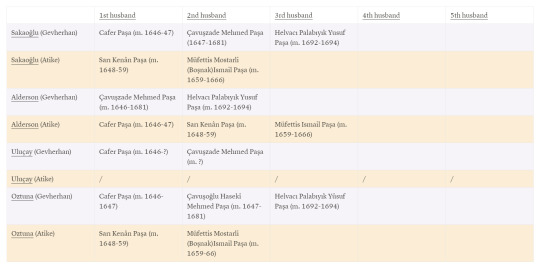
(Uluçay doesn't believe she existed)
As we can see, Oztuna and Sakaoğlu use the same source. Oztuna, though, says that Atike binti Ibrahim was buried in Ibrahim’s mausoleum, while Sakaoğlu says that her burial place is unknown. Curiously, Atike binti Ahmed I is buried in Ibrahim’s mausoleum too.
Since Alderson gave his sources, I went to check. This is a passage from Histoire de l’Empire Ottoman, volume 12, pp. 49-50:
L'ainée, Aïsché, fiancée dès l'age de trois ans à Ipschir-Pascha, épousa à dix Mohammed-Pascha, gouverneur de Haleb; ce dernier ayant été décapité comme faux monnoyeur, elle devint la femme du defterdar Ibrahim, gouverneur du Kaire, puis de Haleb, et alors kapitan-pascha; à sa mort, elle fut mariée à Djanbouladzadé, ancien gouverneur d’Ofen, qui depuis remplit les mêmes fonctions au Kaire. La seconde, nommée Aatika, épousa d'abord le vizir Kenaan-Pascha, puis le vizir Yousouf-Pascha, et en troisième lieu le kapitan Sinan-Pascha, qui avait perdu la bataille des Dardanelles contre les Vénitiens; elle eut pour quatrième époux Ismail-Pascha, grand-inquisiteur en Asie, qui fut tué à la bataille de Saint-Gotthardt; enfin elle contracta une cinquième union avec KasimPascha, l'un des pages de la chambre intérieure, et chirurgien de profession, qui, lors de la circoncision du sultan Mohammed , sut arrêter, au moyen d'une poudre astringente, une hémorrhagie qui avait fait tomber le prince-en défaillance, service que ce dernier récompensa plus tard en donnant à Kasim le gouvernement de Temeswar. […] le Sultan, en reconnaissance du sang qu'il lui avait conservé, refusa de répandre le sien, et, pour le sauver, lui donna la main de sa sœur, qu’un vice de conformation avait empêchée d'appartenir à ses premiers maris, et qui, après dix-neuf ans de mariage, entra vierge dans le harem de Kasim. Celui-ci la délivra de son infirmité au moyen d'ine opération qu’il pratiqua pendant le sommeil d'Aatika, assoupie par un narcotique. Ce fut ainsi qu'il acquit des titres puissans aux bonnes grâces de la princesse, comme précédemment il avait mérité la faveur particulière de Mohammed IV.
Doesn’t it kind of sound like de la Croix (below)? I think Hammer’s source is him.
"La premiere fut mariée à trois ans, & estoit à dix avec son second mary Assaki Mehemet Pasha, Gouverneur d’Alep, il fut étranglé sous pretexte de fausse monnoye, & elle se maria pour la troisiéme fois avec Ibrahim Pacha Tefterdar, du depuis Pacha du Kaire, d’Alep, & enfin Capitan Pacha, aprés la mort duquel Jemblat Oglou Gouverneur du Kaire l’a épousée en quatriéme nopces. La seconde mariée aussi jeune que sa soeur, a eu cinq maris, dont le dernier la prit vierge, à cause d’un défaut de nature (...) Je ne sçay pas le nom des deux premiers, le troisiéme fut Sinan Pacha, lequel estant Capitan Pacha, perdit la Bataille des Dardanelles (...) Le quetriéme estoit Ismael Pacha, ce grand Seigneur l’ayant choisi pour un des Lieutenans generaux de l’armée d’Hongrie (...) Le cinquiéme s’appelle Kassum Pacha, il est Chirurgien de profession”
Now, I think Hammer starts with a mistake because Ibsir Mustafa Pasha was one of Ayşe binti Ahmed I’s husbands. Also, it’s impossible to say where he found that Mehmed IV’s eldest sister was named Ayşe. After these mistakes, though, he repeats what de la Croix said: Haseki Mehmed Pasha, Defterdar Ibrahim Pasha, Canbuladzâde Pasha. The second sister is named Atike (so he says) and stayed a virgin until her last husband, Cerrah Kasim Pasha, operated on her to solve some kind of physical problem she had. This story is similar to the one reported by Rycaut, but he named her Gevherhan instead:
At this tenderness of Age, Sultan Ibrahim, Father of the present Grand Signior, married three of his Daughters; one of which called Gheaher Han Sultan, hath had already five Husbands, and yet, as is reported by the World, remains a Virgin; the last Husband deceased was Ishmael Pasha, who was slain in the passage of the River Raab; and is now again married to Gurgi Mahomet Pasha of Buda, a Man of 90 Years of Age, but rich and able to maintain the greatness of her Court, though not to comply with the youthfulness of her Bed, to which he is a stranger like the rest of her preceding Husbands. — p. 40.
It’s possible that Rycaut had already left the Ottoman Empire when this princess married Cerrah Kasim Pasha. He’s the only one talking about Gurci Mehmed Pasha, though… Interestingly, Sakaoğlu corrects Rycaut’s Gürcü into “(Çavuşzade, Haseki)” but, admittedly, his quote is quite different from Rycaut’s original. In Sakaoğlu’s it is said that the pasha is 30, while Rycaut says he’s 90. Moreover, as far as I know, Çavuşzade Mehmed Pasha was never governor of Buda.
In conclusion, I’m more confused than before lol
As for Mehmed IV’s full sister, I really have no opinion on this. Usually, it’s Beyhan who is given as Turhan Hatice’s daughter but with no hard evidence.
You (and other people) can send me asks on ottomanladies now, I have re-opened my ask box. As I have already said, please be patient with me because I don't have much free time and these things need to be analyzed properly :D
22 notes
·
View notes
Text
Non real life sultanas
A little Christmas surprise post comes. One of my most popular videos on Youtube was the one, where I gathered non-historical characters, explaining how fictional or how historical they were, and if there was a real historical person behind them as an inspirer. Now, for Christmas, I would like to summarize for you the main fictional characters of the Muhteşem Yüzyil series.
Several fictional characters were present in the Muhteşem Yüzyil series, many from the very first minutes. The presence of some fictional characters was forgivable, as we were left with very little detailed information about the harem of Sultan Suleiman I. Thus, for example, the characters of Sümbül Agha, Gül Agha, Mercan Agha, and other eunuchs, although not portraying historical characters, were necessary for the dramaturgy of the series. Sümbül's character was the most important among the eunuchs and perhaps this is why many of us may think that Hürrem actually had such a close friend in the person of the chief eunuch. However, this is not true. During Suleiman's reign, many chief eunuchs took turns, and none of them were known to be particularly close to Hürrem. Of Hürrem's close servants, only one is known by name, a woman named Nevbahar. The characters of Nigar Kalfa, Gülsah Hatun, Fidan Hatun, Daye Hatun, Fahriye Kalfa were similar to Sümbül. None of them were historical, but surely every sultana had their own trusted servants, as they showed in the series. Like the eunuchs and kalfas, the concubines of Prince Mustafa and Prince Bayezid, Ayşe, Rana, Defne or Rumeysa Hatun, can also be considered forgivable fictional characters. We do not know anything about the harem of the two princes as neither of them had a major consort and as their children were born from different women.
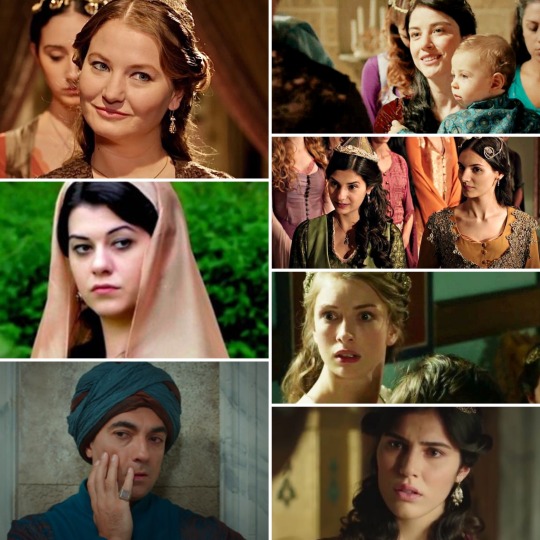
However, there were also characters who were written into the story just for the sake of the drama. Which of these characters was acceptable is up to everyone and feel free to write your opinion about them in a comment here or on another platform! So here's the long-awaited list:
Sadika Hatun
Sadika was a Hungarian woman in the series whose husband was killed by Sultan Suleiman on the day of their wedding. Sadika then became the spy of the Hungarian king, Lajos II and she traveled to Istanbul to personally avenge her husband’s death. Matrakci Nasuh Efendi then, by chance, meets the girl and helps her get into the harem, where she immediately joins Ayşe Hafsa Valide Sultan's service and then becomes Hatice Sultan’s chief servant. During her job, of course, she gets close to Suleiman's bed several times, and then she had the opportunity to attack the sultan. However, she does not succeed, Suleiman survives, and Sadika is thrown in the Bosphorus.
In reality, this story would not be possible at all. Even if we assumed that Sadika really existed and Suleiman actually killed her husband, she would not have been able to get into the Sultan's harem and take revenge. On the one hand, Sadika was already a married woman, an adult woman. Such women could not enter the harem, only virgin, child girls could become the sultan's later concubines. However, even if Sadika had somehow been able to get in the harem, a long education would have awaited her before she could join the Valide Sultan's service. While there may have been some exceptional cases where older or non-virgin women wanted to be gifted to the Sultan, these are special cases. Such was the case, for example, when Hayreddin Barbarossa wanted to kidnap the beautiful Giulia Gonzaga, a widowed Italian noblewoman known far and wide, to send her to the Sultan's harem as a gift. In the end, he didn’t succeed, but even if he did, we don’t know if the sultan would had ever taken the woman to his bed.
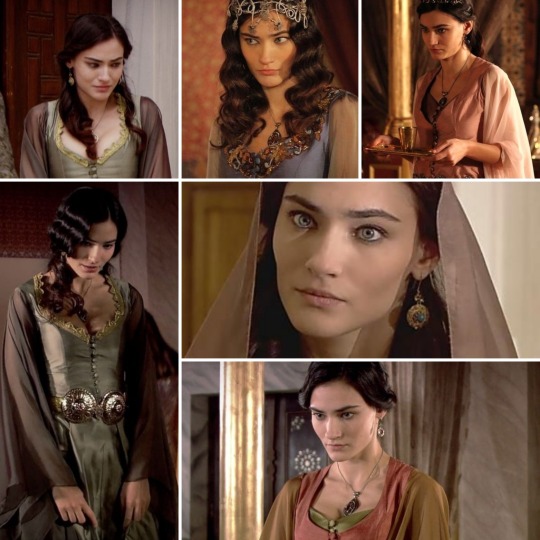
Leo
In the series, he was the love of Hürrem from their youth. Leo came to Istanbul with the goal of finding her former sweetheart. Leo is a talented artist who, with the help of Nasuh Efendi (ahh Nasuh brought all the good people near to the Sultan…) will become the painter of Sultan Suleiman and Pargali Ibrahim. His former relationship with Hürrem will soon be revealed to Pargali Ibrahim, who is thus trying to blackmail Hürrem. Hürrem repeatedly begs Leo to leave the capital, but the man remains, which eventually leads to his death.
In reality, Hürrem - and all the other concubines - were taken into Ottoman captivity as little girls, so it is out of the question that they would have had a love or a fiance. And even if they had, they could never have found them. Nasuh Efendi, though one of the greatest suckers in the series - yet the dearest character - was not like that in reality at all, but he was a wonderful scholar who, by the way, was not so closely friends with either Sultan Suleiman or Pargali Ibrahim.

Princess Isabella
Princess Isabella Fortuna was a Spanish noble lady in the series who was on a ship to her future husband, the Austrian prince, when she was captured by Ottoman pirates and was taken to Istanbul to Sultan Suleiman. At first, Suleiman was only interested in the princess for political reasons, but later he fell in love. Princess Isabella initially resisted Suleiman's approach with all her cartilage, but over time she fell in love with the sultan and became his lover. This, of course, Hürrem could not stand and did everything she could to get rid of the princess who was eventually sent home by Suleiman himself.
In reality, of course, such a situation would have been unthinkable. Even assuming that Isabella existed and was captured by pirates, no princess raised in the Catholic faith would have voluntarily become the concubine of a Muslim sultan, she would have committed suicide instead. Let us not forget that Suleiman was loyal to Hürrem from the 1520s onwards, so in reality there was not a single woman who could make hard time for Hürrem during her decades-long relationship with Suleiman. Isabella Fortuna, on the other hand, never existed. Surprisingly, however, they could have patterned her from a real character. There was an Isabella of Castile in this period who was born in 1518 as the child of the widowed Queen of Aragon, Germaine of Foix and Charles V, but she was never captured by Ottoman pirates and was never the bride of the Austrian prince. Isabella's existence was kept secret by her parents all her life, only her mother's testament revealed that she ever existed. It is also known from there that Isabella died young in 1537.
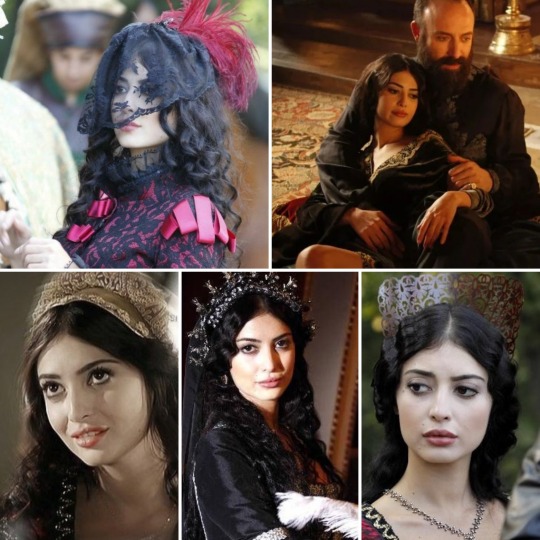
Aybige Hatun
In the series, Aybige was the niece of Ayşe Hafsa, and so the daughter of the Crimean Sahib Giray khan. Aybige originally only came to visit her aunt in Istanbul, but later Hafsa Sultan wanted to see her as the wife of her favorite grandson, Prince Mustafa. However, Aybige was in love with Bali Bey and Mustafa longed for someone else aksi. Bali Bey was eventually almost executed for their love, and Aybige returned to Crimea with her father in the end.
Aybige’s storyline makes mistakes at almost every point. First, Ayşe Hafsa was never the sister of the Crimean khan, so the daughter of the Crimean khan could not have been her niece either. In addition, although Sahib Giray Khan had several daughters, none were called Aybige and none of his daughters ever traveled to Istanbul. The only true point in the whole storyline is that Sahib Giray Khan really collaborated with Sultan Suleiman in his Moldovan war. It is also important to mention Bali Bey at this point. Although Bali Bey was a real historical figure, there is not the slightest match between historical Bali Bey and the series Bali Bey. The real Bali Bey was not a romantic guy who fell in love with every second woman. Bali Bey was a cruel warlord. And if it comes to Bali Bey, let’s say a few words about Prince Mustafa as well. The idea of wanting to marry Mustafa to a khan’s daughter is completely absurd! Since the reign of Sultan Mehmed II, princes have been forbidden to marry anyone, so Prince Mustafa has not been allowed to marry anyone either. And the fact that Suleiman would have supported the idea - even if such a marriage had been able to occurre at all - is an even greater absurdity. Suleiman did not want Mustafa as his heir, so he would never have given him as much power as the support of the Crimean khan.
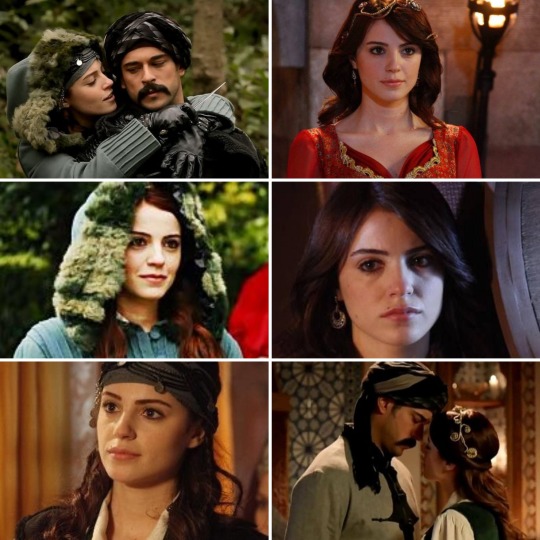
Firuze Hatun
In the series, Firuze was a Persian spy who, with her amazing abilities, was able to heal the pains of the sick Prince Cihangir, earning the love of Hürrem Sultan. Firuze, however, thanked Hürrem kindness in a disgusting way, and became Suleiman's secret lover, whom the sultan fell in love with. In the end, Hürrem was only able to overcome Firuzen with a little, Firuze was eventually exiled from the palace so she could return to Persia.
In reality, Suleiman was loyal to Hürrem, living in a monogamous relationship with her. Even if there was an occasional one-night-stands, Suleiman never fell in love with another woman, only Hürrem. Thus, the Firuze storyline has already failed here. The fact that there was a Persian spy in the harem would have been an interesting suggestion though. There were certainly spies in the royal court of every empire, but they were probably not hiding among the concubines. Eunuchs, for example, moved with much greater freedom, were much better candidates for being a spy…
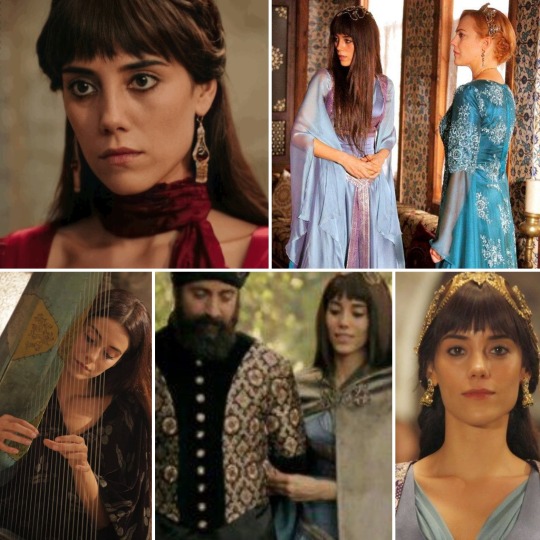
Huricihan Sultan
In the series, Huricihan was the daughter of Ibrahim Pasha and Hatice Sultan, who grew up in the palace of Beyhan Sultan after the death of her parents. From there she returned to Istanbul, where she fell in love with her first cousin, Prince Bayezid. Their love became a relationship and then marriage without the Sultan’s permission. Huricihan became the head of Bayezid's harem and soon her relationship with Hürrem and Suleiman slowly became better. Huricihan's end eventually was brought by Prince Selim's concubine, Nurbanu, who knocked her out in the heat of a dispute, killing her.
In reality, Hatice and Ibrahim Pasha were never married, so they didn't have children either together, so Huricihan never existed. If she had existed, for the reasons already mentioned, it would have been utterly inconceivable for Bayezid to marry her, either secretly or openly. Especially knowing that Bayezid had never had a favourite singled out concubine, as all of his children were born to different women. With a background like this, it’s unlikely he’d ever wanted to marry anyone. Although Hatice Sultan did indeed have a daughter, she was born between 1510 and 1515, so she was well ahead of Bayezid in age, and of course she had nothing to do with the prince and was not even called Huricihan.
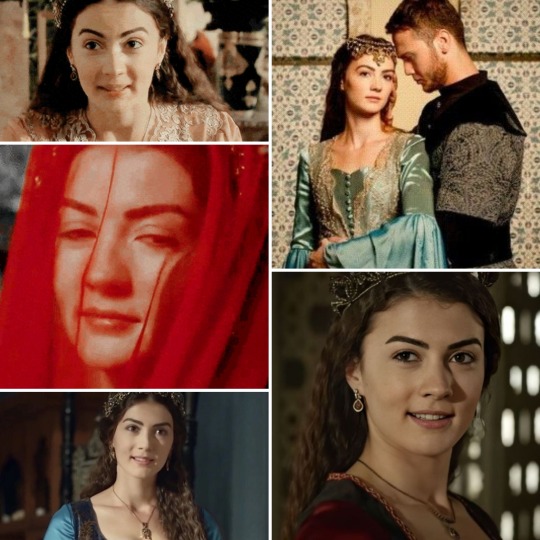
Mihrünissa Hatun
In the series, Mihrünissa was the daughter of Hayreddin Barbarossa the Head of the Fleet, whom her father sent to Prince Mustafa as a consultant. Later, the two young person fell in love with each other and married without the Sultan's knowledge. In time, Mihrünissa also gave birth to Mustafa's son Mehmed. After Prince Mustafa and his son Mehmed were executed, Mihrünissa went to the capital and cut her own throat before Hürrem's eyes.
In reality, for the reasons already detailed several times above, no prince could marry anyone, so Mustafa also never married. In addition, Barbarossa never had a daughter named Mihrünissa and Hayreddin Pasha was never a supporter of Prince Mustafa. However, even assuming that Mihrünissa existed, there is no chance that she could have committed suicide before Hürrem's eyes. Prince Mustafa's harem retired to Bursa, so that no member of the harem could travel to the capital, especially not to the palace and kill herself in front of Hürrem. So, in fact, the Mihrünissa storyline was just 100% fiction.
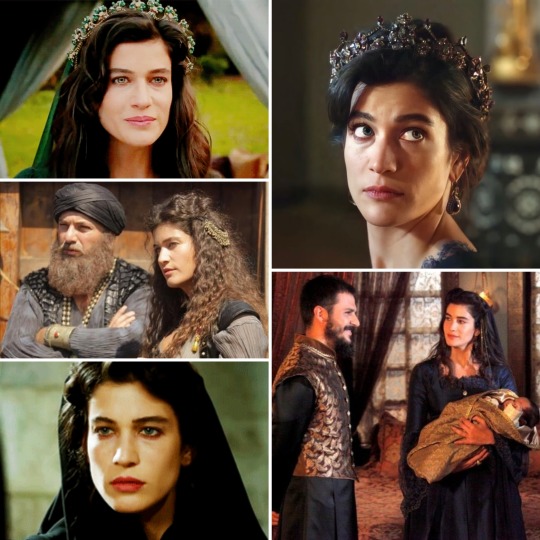
Nazenin Hatun
In the series, Nazenin arrived in Istanbul with Nurbanu, where Hürrem, who was struggling with menopause, sent her to the sultan herself. Nazenin thus became the sultan's concubine and soon gave birth to a daughter, Raziye Sultan. Eventually, on Hürrem's instructions, she was killed by Nurbanu.
In reality, as I have said many times, Suleiman was loyal to Hürrem. In addition, after the birth of Prince Cihangir in 1531/2, Suleiman had no more children, neither to Hürrem nor to anyone else. It is true that he had a daughter named Raziye, however, the child died in 1520 at the age of a few years as a result of an epidemic.
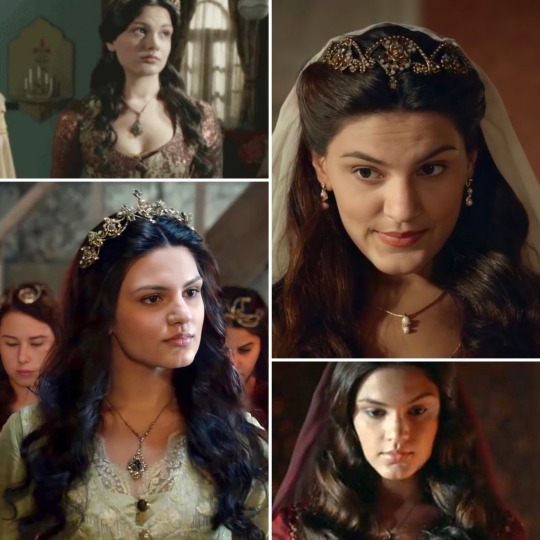
Surprising realities
After many fictional characters, one would think that all eunuchs and kalfas were fictional characters, as we know quite a bit about the harem. However, this is not true! There were some historically inspired characters, such as Gazanfer Agha, who, although existed and was one of the most influential eunuchs ever, was not a loyal man of Nurbanu, but Sultan Selim II. Gazanfer reached the peak of his career, by the way, during the reign of Safiye Sultan.
Similarly historical was Canfeda Hatun, who was Nurbanu’s most loyal servant and one of the most influential kalfas of her era. True, Canfeda’s character in the series was a fusion of two loyal servants of historic Nurbanu. In her young age, in the princely harem of Selim, Nurbanu became acquainted not with Canfeda but with another kalfa, who remained her faithful servant for the rest of her life. Canfeda only became Nurbanu’s main supporter during Selim’s reign.
Like them, Afife Hatun’s character was partly real also. Sultan Suleiman's wetnurse was really called Afife and the sultan always kept in touch with the woman. However, Afife Hatun never moved to Istanbul to rule the Sultan’s harem, but lived a simple life.
Gracia Mendes Nasi was introduced last season as a wealthy Portuguese Jewish woman who helped Portuguese refugees get to Istanbul. Later, Gracia became the lover of Grand Vizier Rüstem Pasha, which made her an enemy of Mihrimah Sultan. In reality, Gracia Mendes was a very benevolent soul who was committed to Jewish traditions and her Jewish brothers. She was never a lover of Rustem and an enemy of Mihrimah. However, like the series, Gracia actually enjoyed the Sultan’s support and, with his help, she made great improvements in Istanbul’s Jewish Quarter and helped many refugees start a new life in the Ottoman Empire.
One of the most interesting guest actors of the last season of the series was Anna Jagello, the daughter of the former King of Poland, the sister of the new King of Poland. Although the woman was a real historical figure, the historical Anna never traveled to Istanbul and never corresponded with Hürrem Sultan. However, Hürrem exchanged letters several times with Anna's mother Bona Sforza, Anna's father, King Sigismund I of Poland, and Anna's brother, the later Zsigmond Ágost II king of Poland, and even Anna's sisterm Isabella, the Hungarian queen. Thanks to the intercession of Hürrem, the relationship between the Kingdom of Poland and the Ottoman Empire was quite good and almost friendly during Suleiman's reign.
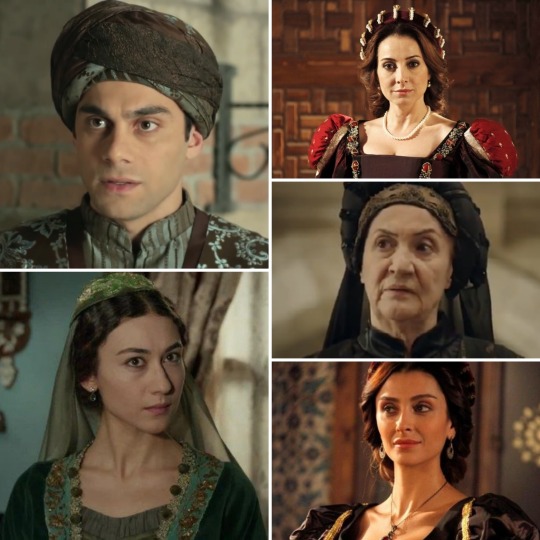
* * *
Egy kis karácsonyi meglepetés poszt következik. Youtube-on az egyik legnépszerűbb videóm az volt, amelyben a nem történelmi karaktereket gyűjtöttem össze, elmagyarázva, mennyire voltak kitaláltak, mennyire volt mögöttük egy-egy valós történelmi személy, mint ihlető. Most karácsony alkalmából szeretném nektek összefoglalni a Muhteşem Yüzyil sorozat főbb kitalált karaktereit és történetüket.
A Muhteşem Yüzyil sorozatban több kitalált karakter is jelen volt, sokan már az első percektől kezdve. Egyes kitalált karakterek jelenléte megbocsátható volt, hiszen nagyon kevés részlet maradt ránk a Szulejmán háremében jelenlévő személyekről. Így például Sümbül Aga, Gül Aga, Mercan Aga és más eunuchok karakterei bár nem valódi személyeket keltenek életre, szükségesek voltak a sorozat dramaturgiája szempontjából. Sümbül karaktere volt a legfontosabb az eunuchok között és talán emiatt sokan gondolhatjuk úgy, hogy Hürremnek a valóságban is volt egy ilyen közeli barátja a fő eunuch személyében. Azonban ez nem igaz. Szulejmán uralkodása alatt rengeteg főeunuch váltotta egymást és egyikről sem ismert, hogy különösebben közel álltak volna Hürremhez. Hürrem közeli szolgálói közül csupán egy ismert név szerint, egy Nevbahar nevű nő. Sümbülhöz hasonló volt Nigar Kalfa, Gülsah Hatun, Fidan Hatun, Daye Hatun, Fahriye Kalfa karaktere is. Egyikük sem valós személy volt, ám bizonyosan minden szultánának megvoltak a saját megbízható szolgálói, ahogy ezt a sorozatban is mutatták. Hasonlóan az eunuchokhoz és kalfákhoz megbocsátható füllentésnek tekinthetőek Musztafa herceg és Bayezid herceg ágyasai is, Ayşe, Rana, Defne vagy Rumeysa Hatun. A két herceg asszonyairól ugyanis semmit sem tudunk, egyiküknek sem volt kiemelt jelentőségű főágyasa, gyermekeik más-más nőktől születtek.
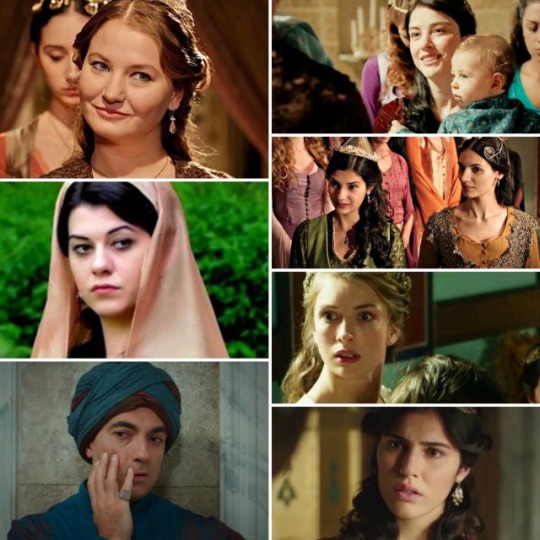
Voltak azonban olyan karakterek is, akiket csupán a dráma kedvéért írtak bele a történetbe. Az, hogy ezek közül melyik karakter mennyire volt elfogadható, azt mindenki maga döntse el és nyugodtan írja meg kommentben itt vagy más platformon, hogy mit gondol róluk! Következzék hát a várva várt lista:
Sadika Hatun
Sadika a sorozatban egy magyar nő volt, akinek férjét az esküvőjük napján megölte Szulejmán szultán. Sadika ezek után a magyar király, II. Lajos parancsára Isztambulba utazott, hogy ott személyesen bosszulja meg férje halálát. Matrakci Nasuh Efendi aztán egy véletlen folytán megismerkedik a lánnyal és segít neki bekerülni a hárembe, ahol azonnal Ayşe Hafsa Valide Sultan szolgálatába áll, majd Hatice Sultan főszolgálója lesz. Menetközben természetesen többször is Szulejmán ágyának közelébe kerül, majd lehetősége nyílik a szultánra támadni. Azonban nem jár sikerrel, Szulejmán életben marad, Sadikát pedig a Boszporuszba fojtják.
A valóságban ez a történetszál egyáltalán nem lenne lehetséges. Ha feltételeznénk is azt, hogy Sadika valóban létezett és Szulejmán valóban megölte a férjét, akkor sem állt volna módjába bejutni a szultáni hárembe és bosszút állni. Egyrészt Sadika férjezett asszony volt már, felnőtt nő. A hárembe nem kerülhettek be ilyen nők, csupán szűz, gyermeklányokból válhattak a szultán ágyasai. Mindazonáltal ha Sadika valahogy mégis bekerült volna a hárembe hosszadalmas oktatás várt volna rá, mielőtt a Valide Sultan szolgálatába állhatott volna. Előfordulhatott ugyan néhány kivételes eset, amikor idősebb vagy nem szűz nőket akartak volna a szultánnak ajándékozni, azonban ezek különleges esetek. Ilyen volt például, amikor Hayreddin Barbarossa el akarta rabolni a messze földön ismert, gyönyörű Giulia Gonzagát, megözvegyült itáliai nemesasszonyt, hogy a szultán háremébe küldje ajándéknak. Végül nem járt sikerrel, ám ha sikerrel járt volna is, nem tudni, hogy a szultán valaha is ágyba vitte volna-e a nőt.
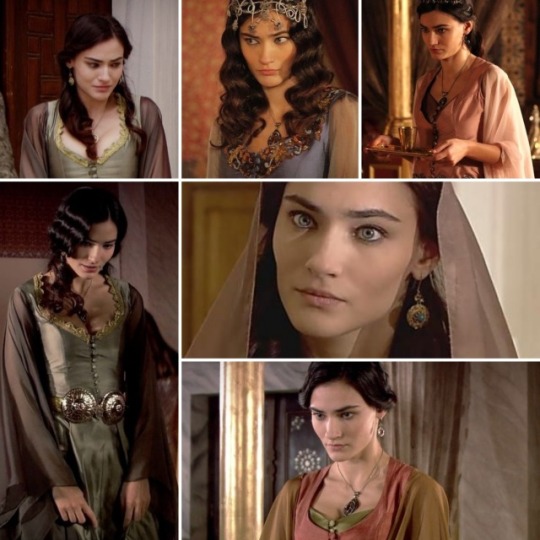
Leo
A sorozatban Leo Hürrem fiatalkori szerelme volt, aki azzal a céllal érkezett Isztambulba, hogy megtalálja egykori kedvesét. Leo tehetséges művész, aki Nasuh Efendi segítségével (ahh Nasuh csupa jó embert juttatott a szultán közelébe…) Szulejmán szultán és Pargali Ibrahim festője lesz. Egykori viszonya Hürremmel hamarosan kiderül Pargali Ibrahim számára, aki ezzel próbálja zsarolni Hürremet. Hürrem többször könyörög Leonak, hogy hagyja el a fővárost, de a szerelmes férfi marad, ami végül halálához vezet.
A valóságban Hürrem – és minden más ágyas – még kislányként került oszmán fogságba, tehát kizárt, hogy szerelmük vagy vőlegényük lett volna, ha pedig mégis, az sosem tudott volna rájuk találni. Nasuh Efendi, pedig aki a sorozat egyik legnagyobb baleke – ugyanakkor legkedvesebb karaktere – a valóságban egyáltalán nem ilyen volt, hanem egy csodálatos tudós, aki egyébként nem állt ilyen közeli barátságban sem Szulejmán szultánnal, sem Pargali Ibrahimmal.
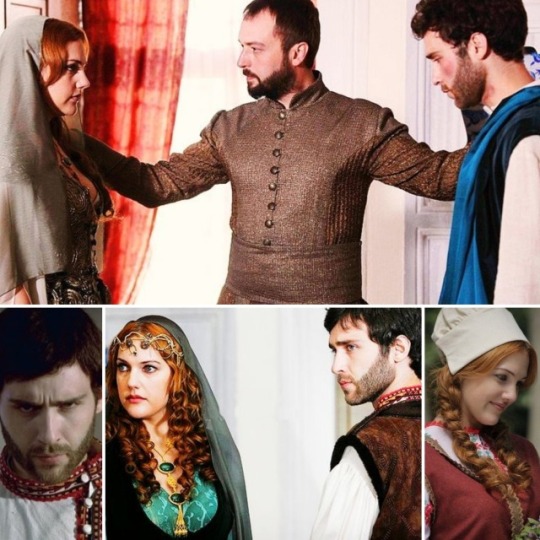
Izabella Hercegnő
Izabella Fortuna hercegnő a sorozatban egy spanyol nemes hölgy volt, aki éppen jövendőbeli férjéhez, az osztrák herceghez tartott hajón, mikor az oszmán kalózok elragadták és Isztambulba vitték Szulejmán szultán elé. Először Szulejmán politikai okokból érdeklődött csupán a hercegnő iránt, később azonban beleszeretett. Izabella hercegnő eleinte minden porcikájával ellenállt Szulejmán közeledésének, idővel azonban beleszeretett a szultánba és a szeretője lett. Ezt természetesen Hürrem szultána nem állhatta és mindent megtett, hogy megszabaduljon a hercegnőtől, akit végül Szulejmán küldött el.
A valóságban természetesen elképzelhetetlen lett volna egy ilyen szituáció. Ha feltételezzük is, hogy Izabella létezett és a kalózok fogságába esett, egyetlen katolikus hitben nevelt hercegnő sem vált volna szabad akaratából a szultán ágyasává, előbb lett volna öngyilkos. Azt se felejtsük el, hogy Szulejmán az 1520-as évektől kezdve hűséges volt Hürremhez, a valóságban nem volt egyetlen nő sem, aki éket verhetett volna közéjük több évtizedes kapcsolatuk alatt. Másrészről pedig Izabella Fortuna sosem létezett. Meglepő azonban, hogy valós karakterről mintázhatták. Létezett egy Kasztíliai Izabella ebben a korban, aki 1518-ban született az özvegy aragóniai királyné Germaine Foix és V. Károly gyermekeként, azonban sosem esett oszmán kalózok csapdájába és sosem volt az osztrák herceg menyasszonya. Izabella létezését egész életében titokban tartották szülei, csupán édesanyja végrendeletéből derült fény arra, hogy valaha is létezett. Innen tudni azt is, hogy Izabella fiatalon elhunyt 1537-ben.
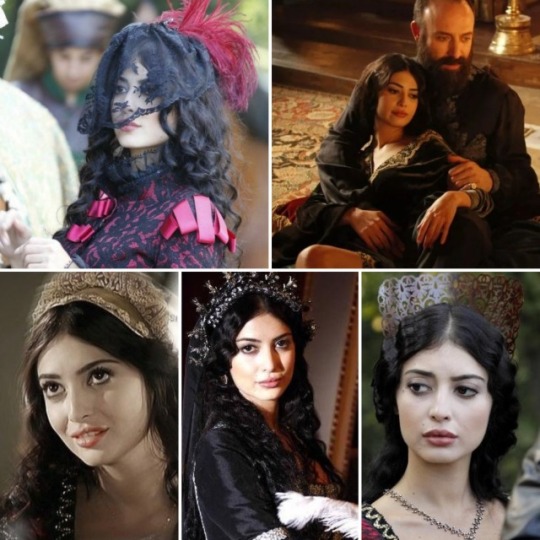
Aybige Hatun
A sorozatban Aybige Ayşe Hafsa Sultan unokahúga volt, a krími Sahib Giray kán lánya. Aybige eredetileg csak látogatóba érkezett Isztambulba, később azonban nagynénje szerette volna őt kedvenc unokája, Musztafa herceg feleségeként látni. Aybige azonban Bali Bégbe volt szerelmes és Musztafa is más után vágyakozott. Bali Béget végül majdnem kivégezték a szerelmük miatt, Aybige pedig apjával visszatért a Krímre.
Aybige történetszála szinte minden létező ponton hibádzik. Először is, Ayşe Hafsa sosem volt a Krími kán testvére, tehát a krími kán lánya sem lehetett az unokahúga. Emellett Sahib Giray kánnak bár több lánya volt, egyiket sem hívták Aybigének és egyik lánya sem utazott sosem Isztambulba. Az egész történetszál egyetlen igaz pontja, hogy Sahib Giray kán tényleg együttműködött Szulejmán szultánnal annak moldáv háborújában. Fontos megemlíteni ezen a ponton Bali Béget is. Bali Bég bár valós történelmi személy volt, de a legkisebb egyezés sincs a történelmi Bali Bég és a sorozat Bali Bége között. A valódi Bali Bég nem egy romantikus fickó volt, aki minden második nőbe beleszeretett, és akiért bolondultak a nők. Bali Bég egy kegyetlen hadvezér volt. És ha már Bali Bég szóba jött, ejtsünk néhány szót Musztafa hercegről is. Az ötlet, hogy Musztafát egy kán lányához akarják adni teljesen abszurd! II. Mehmed szultán uralkodása óta tilos volt a hercegeknek házasságot kötni, így Musztafa herceg sem köthetett senkivel házasságot. Az pedig, hogy Szulejmán támogatta volna az ötletet, már ha egyáltalán felmerült volna egy ilyen házasság, még nagyobb abszurdum. Szulejmán nem Musztafát akarta örökösének, így sosem adott volna a kezébe akkora hatalmat, mint a krími kán támogatása.
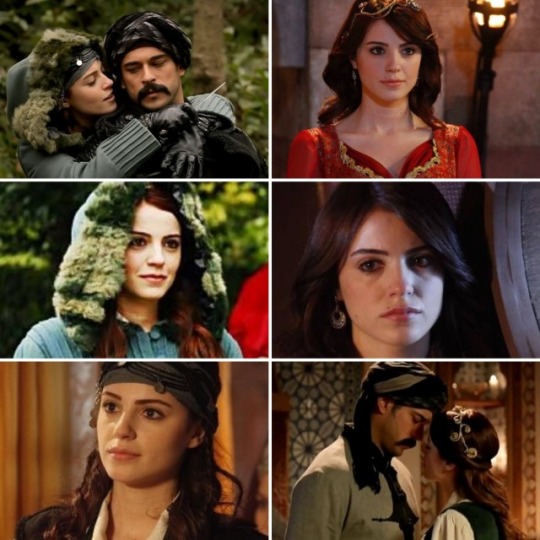
Firuze Hatun
A sorozatban Firuze egy perzsa kém volt, aki csodálatos képességeivel gyógyítani tudta a beteges Cihangir herceg fájdalmait, amivel kiérdemelte Hürrem szeretetét. Firuze azonban rút módon hálálta meg Hürrem kedvességét, ugyanis Szulejmán titkos szeretője lett, akibe a szultán halálosan beleszeretett. Végül Hürrem csak egy hajszállal volt képes felülkerekedni Firuzén, akit végül száműztek a palotából, így visszatérhetett Perzsiába.
A valóságban Szulejmán hűséges volt Hürremhez, monogám kapcsolatban éltek. Ha előfordult is alkalomadtán egy-egy egyéjszakás kaland, Szulejmán soha nem szeretett bele más nőbe, csak Hürremet szerette. Így a Firuze történetszál már itt el is bukott. A tény, hogy Firuze perzsa kém lett volna érdekes felvetés, bizonyára akadtak kémek minden birodalom királyi udvarába, azonban ők valószínűleg nem az ágyasok között rejtőztek. Az eunuchok például, sokkal nagyobb szabadsággal mozogtak, sokkal könnyebben lefizethetők voltak…
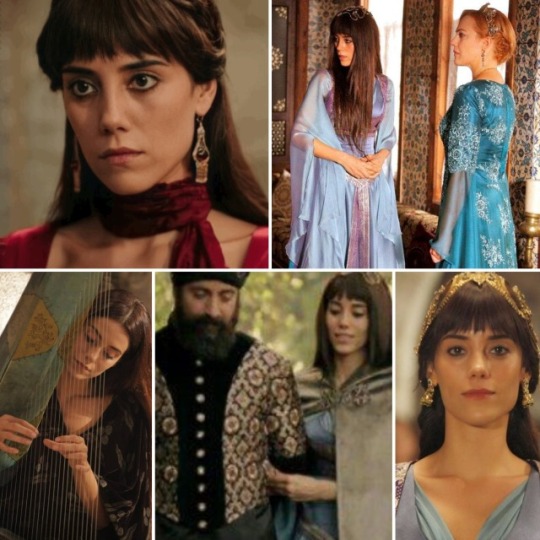
Huricihan Sultan
A sorozatban Huricihan Ibrahim Pasa és Hatice Sultan lánya volt, aki szülei halála után Beyhan Sultan palotájában nevelkedett. Onnan tért vissza Isztambulba, ahol beleszeretett elsőunokatestvérébe, Bayezid hercegbe. Szerelmükből kapcsolat, majd házasság lett a szultán engedélye nélkül. Huricihan Bayezid háremének feje lett és kapcsolata lassanként rendbejött Hürremmel és a szultánnal is. Huricihan végzete végül Szelim herceg ágyasa, Nurbanu lett, aki egy vita hevében leütötte őt, ezzel megölve.
A valóságban Hatice és Ibrahim Pasa sosem voltak házasok, így gyermekük sem született, tehát Huricihan sosem létezett. Ha létezett volna is, a már korábban említett okokból teljesen elképzelhetetlen lett volna, hogy Bayezid feleségül vegye őt akár titokban, akár nyíltan. Különösen tudva, hogy Bayezidnek nem volt sosem kiemelt ágyasa, minden gyermeke más nőtől született. Ilyen háttérrel nem valószínű, hogy valaha is feleségül akart volna venni bárkit. Hatice Sultannak bár valóban volt egy lánya, az 1510-1515 között született, így korban jóval megelőzte Bayezidet, és természetesen sosem volt semmi köze a herceghez és nem is Huricihannak hívták.
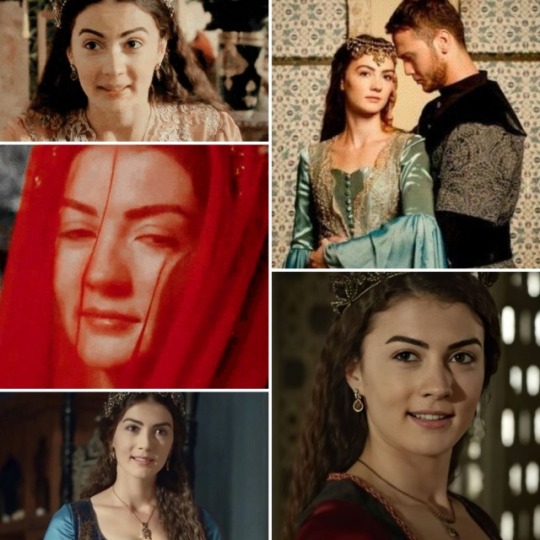
Mihrünissa Hatun
A sorozatban Mihrünissa Hayreddin Barbarossa flotta parancsnok lánya volt, akit édesapja küldött Musztafa herceg mellé tanácsadónak. Később a két fiatal egymásba szeretett és a szultán tudta nélkül egybe keltek. Idővel Mihrünissa életet adott Musztafa fiának, Mehmednek is. Miután Musztafa herceget és vele együtt fiát, Mehmedet is kivégezték, Mihrünissa a fővárosba ment és Hürrem szeme láttára elvágta a saját torkát.
A valóságban a már fent többszörösen részletezett okok miatt egy herceg sem köthetett házasságot, így Musztafa sem nősült meg soha. Emellett Barbarossának sosem volt Mihrünissa nevű lánya és Hayreddin Pasa sohasem volt Musztafa herceg támogatója. Ha azonban feltételeznénk is, hogy Mihrünissa létezett, nincs arra esély, hogy Hürrem szeme láttára lehetett volna öngyilkos. Musztafa herceg háreme Bursába vonult vissza, így a hárem egyik tagja sem utazhatott egyetlen percre sem a fővárosba, nemhogy a palotába, Hürrem elé. Így tulajdonképpen a Mihrünissa történet-szál 100%-ban kitaláció volt.
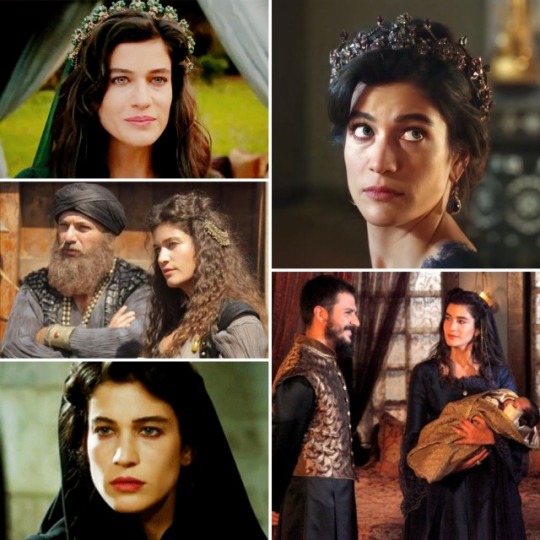
Nazenin Hatun
A sorozatban Nazenin Nurbanuval együtt érkezett Isztambulba, ahol aztán a menopauzával küszködő Hürrem maga küldte őt a szultán elé. Nazenin így a szultán ágyasa lett és hamarosan egy lánygyermeknek, Raziye Sultannak adott életet. Végül Hürrem utasítására Nurbanu ölte meg.
A valóságban, mint már sokszor mondtam, Szulejmán hűséges volt Hürremhez. Emellett Cihangir herceg 1531/2-es születése után Szulejmán nem nemzett több gyermeket, sem Hürremnek sem másnak. Az igaz, hogy volt egy Raziye nevű kislánya, azonban a gyermek 1520-ban néhány éves korában elhunyt egy járvány következtében.
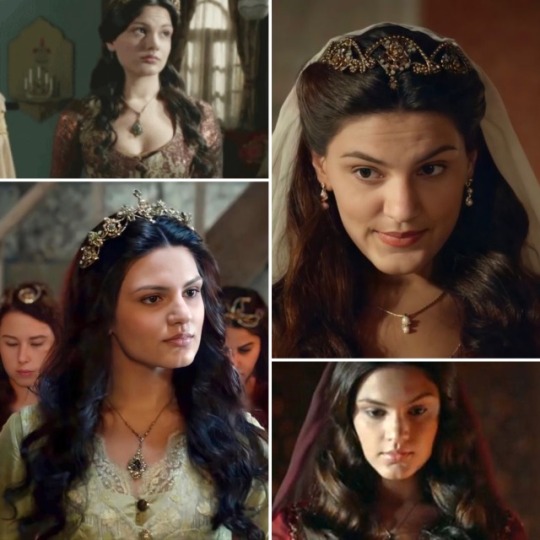
Meglepő valóságok
A sok kitalált karakter után azt gondolhatnánk, hogy az összes eunuch és kalfa kitalált karakter volt, hiszen meglehetősen keveset tudunk a háremről. Azonban ez nem igaz! Volt néhány történelmi ihletésű karakter, mint például Gazanfer Aga, aki bár létezett, és a valaha volt egyik legbefolyásosabb eunuch volt, nem Nurbanu hű embere volt, hanem II. Szelim szultáné. Gazanfer pályája csúcsát egyébként Safiye Sultan uralkodása alatt érte el.
Hasonlóan valós volt Canfeda Hatun is, aki Nurbanu leghűségesebb szolgálója volt és az egyik legbefolyásosabb kalfája korának. Igaz, Canfeda sorozatbeli karaktere, a történelmi Nurbanu két hűséges szolgálójának ötvözéseként született meg. Nurbanu fiatal korában, Szelim hercegi háremében nem Canfedával, hanem egy másik kalfával ismerkedett meg, aki élete végéig hűséges szolgálója maradt. Canfeda csak Szelim uralkodása alatt került képbe és vált Nurbanu fő segítőjévé.
Hozzájuk hasonlóan Afife Hatun karaktere is részben valós volt. Szulejmán szultán szoptatósdajkáját tényleg Afifének hívták és a szultán mindig tartotta a kapcsolatot az asszonnyal. Azonban Afife Hatun sosem költözött Isztambulba, hogy irányítsa a szultáni háremet, hanem egyszerű életet élt.
Gracia Mendes Nasi az utolsó évadban került bemutatásra, mint gazdag portugál zsidóasszony, aki portugál menekülteknek segített Isztambulba jutni. Később Gracia a nagyvezír Rüsztem Pasa szeretője lett, aminek köszönhetően szembe került Mihrimah szultánával. A valóságban Gracia Mendes igen jótét lélek volt, aki elkötelezett volt a zsidó hagyományok és zsidó testvérei iránt. Sosem volt Rüsztem szeretője és Mihrimah ellensége. Azonban a sorozathoz hasonlóan, Gracia a valóságban is élvezte a szultán támogatását és segítségével nagy fejlesztéseket vitt véghez Isztambul zsidó negyedében és nagyon sok menekültnek segített új életet kezdeni az Oszmán Birodalomban.
A sorozat utolsó évadának egyik legérdekesebb vendégszereplője Jagelló Anna volt, az egykori lengyel király lánya, az új lengyel király testvére. Bár az asszony valós történelmi személy volt, a történelmi Anna sosem utazott Isztambulba és sosem levelezett Hürrem szultánával. Azonban Hürrem többször is váltott levelet Anna édesanyjával Bona Sforzával, Anna édesapjával, I. Zsigmond lengyel királlyal, valamint Anna testvérével, a későbbi II. Zsigmond Ágost lengyel királlyal, sőt Anna másik testvérével Izabella, magyar királynővel is. Hürrem közbenjárásának köszönhetően Szulejmán uralkodása alatt meglehetősen jó, szinte baráti volt a viszony a Lengyel Királyság és az Oszmán Birodalom között.
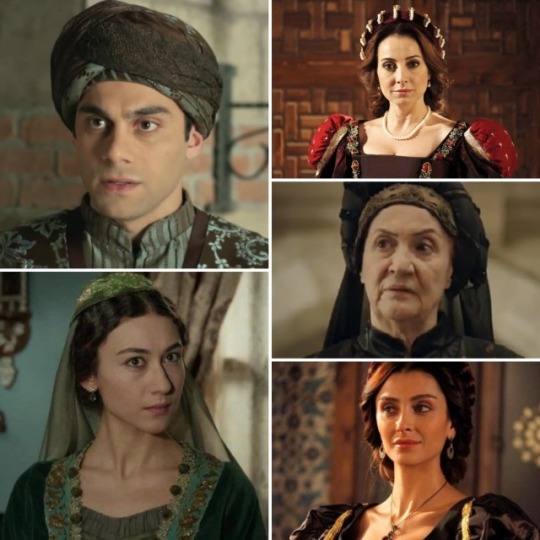
#selim ii#gazanfer agha#gazanfer#suleiman the magnificent#safiye sultan#suleiman i#suleyman i#haseki hürrem sultan#hürrem sultan#nurbanu sultan#aybige hatun#ayse hafsa#ayse hafsa sultan#princess isabella#firuze#firuze hatun
101 notes
·
View notes
Photo
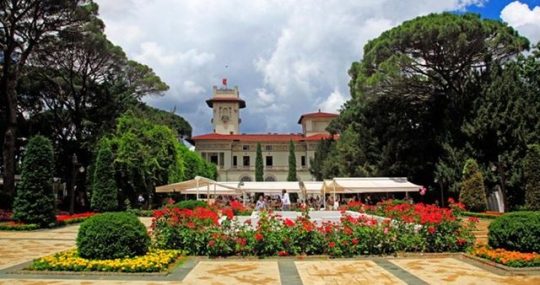
Palace Weddings on the Ottoman Dynasty
Shows and fireworks on the Golden Horn
That day the heart of Istanbul and of the empire was beating at this procession.
The participants wore their best outfits and carried their most valuable arms and pistols. Ahmet III was trying to show his power and wealth to his people with, this street parade instead of revealing his supremacy to the entire world in the battlefields. With the feasts and festivities he organized, with the mansions he had built during the Tulip Era and with all the luxury, he had changed the outlook of the capital city and ushered a new epoch in the Empire. The wedding day was a historic day for Istanbul. Everybody on the streets was happy. Joy was in the air. The streets were overcrowded. The windows were wide open. Faces beneath the veils were praying for the happiness of the bride and for the wealth, dashing look of the Sultan and his procession.
The procession was literally throwing money on the streets. People were stepping on each other to snap the coins. The procession arrived Eyiip, at the palace, prepared for Fatma Sultan. The procession participants disintegrated. Everyone had an entertainment to watch. Padishah and his wife went back to their palace. In the evening shows were staged on the Golden Horn, while fireworks were being lit on rafts.
Silahtar Ali Pasha dies in war
After this tiring and overwhelming wedding, which lasted for 25 days…
Silahtar Ali Pasha could not have Fatma Sultan. He had to send her back to the palace and wait for a while until she grows up and becomes a young lady. Silahtar Ali Pasha had to wait eight years for Fatma Sultan’s adolescence. He never had a chance to have a single private moment with her. Unfortunately, he died in Pclervaradin War before he could reunite with his fiancee, for whom he spent a fortune and organized feasts for weeks in order to gain supporters for his love. He became a martyr before he could realize his dreams.
Kosem Sultan marries her daughters
In the Ottoman Empire, the Sultans could marry before they were adolescents, but they could not share the same house with their spouses. This tradition was started by the well-known empress, Valide Kosem Sultan. For the sake of fortifying her position in the palace, Kosem Sultan married her minor daughters with the elite and reputable pashas of the time. Likewise, Ahmet 1 married her daughters Ayse Sultan and Fatma Sultan at the age of 13.
Sultan Ibrahim married Gevher Sultan at 3, Beyhan Sultan at 2. Emine, Ay§e and Safiye Sultans, the three daughters of Mustafa II, were married at 7. As mentioned above, Ahmet III had his daughters Fatma and Ummugulsum married at 5 and 2. Moreover, he married Atike Sultan at 12. Mustafa III married his son §ah Sultan at 3. This abnormality continued until the reign of MahmuL II, who pul an end to this situation and set the marriage time as the adolescence.
Multiple marriages
This weird tradition described above and the ongoing wars had a natural consequence. The sultans were widowed many times and were married more than once. The daughters of Ahmet I, Ayse, Fatma and Safiye, all married 6 times, which was a dynasty record. This record is followed by Safiye and Emine, daughters of Mustafa II, who married 4 times. So did Atike Sultan, daughter of Ahmet III.
Source: https://www.ensarislamoglu.com/palace-weddings-ottoman-dynasty/
0 notes
Note
Hello,sorry for bothering I saw the topic about the daughters of Sultan Ibrahim,I would like to ask your opinion about who was or were the daughter(s) of Turhan Sultan? Actually did she even have daughters? Hammer mentions that Turhan had tried to save the lives of her sons in laws Sari Kenan Pasa and Haseki Mehmed Pasa from the wrath of Koprulu Mehmed Pasa,but couldn't save their lives due to their participemce in the opposite faction and also because of his corruption deeds which were large too(about Haseki Mehmed Pasa). I read this in the Croatian translation of Hammer's History of Ottoman empire V6(page 458). Whoever were the identitites of(Atike or Gevherhan)of the princess who was wife of Sari Kenan Pasa,and the wife of Haseki Mehmed Pasa(Ayse or Beyhan)seems to be probably daughters of Hatice Turhan Sultan? Also J.Dumas mention in Les perles de nacre sultanate in page 83 Ayse is buried along either to her father Ibrahim or either along Mustafa I. There is also found notebook:Ayşe Sultan’ın Cihaz (Çeyiz) Defteri in name Ayse Sultan about items and jewelry for her dowry in 1682 found in the archives by researchers,who is identified as most likely sister of Mehmed IV. But maybe she was not his sister,but possibly his daughter? Also J.Dumas mention in Les perles de nacre sultanate page 496 mention that Atike(daughter of Ibrahim I) was married 4 times:firstly to Cafer Pasa,secondly to Sari Kenan Pasa,thirdly to Mostarli Ismail Pasa and forthly to Cerah Kasim Pasa. There is also article about Rabia Sultan(Haseki of Ahmed II)-Kuzguncuk Asiye Sultan ve Haseki Rabia Sultan Yalilari,which mentiones that Gevherhan Sultan(daughter of Ibrahim I),had left her lands and mansions to the haseki of Ahmed II-Rabia Sultan and his daughter Asiye Sultan. Ragusian sources also mention Kaya Sultan(daughter of Ibrahim I)as Safiye Sultan dated in 1662 as widow of Haydaragzade Mehmed Pasa in Per favore de la soltana in page 113. Hammer also claims that Kaya Sultan was sister of Suleiman II(according to the Croatian translation that they shared same mother this is it mentioned in page 431 accordring to Croatian translation). In your opinion did Atike(daughter of Ibrahim I) existed after all and if she didn't who was the sister said by contemporary sources to be own sister of Mehmed IV? Also in the Croatian translation(page 494)of Hammer' History of Ottoman empire V6,that Turhan Sultan had took under her care and raised the orphan son of some man named Ali. Do you know who was that man Ali excatly and how was he clouse to Mehmed IV? Once again sorry for bothering and for the many questions.
Hello and no problem, you’re not bothering!!
So, I can’t read your citations because I use the French version of Hammer’s work and I can’t find what you’re talking about because I think the books are divided differently. Volume 6 of the French version goes from 1547 to 1574.
Anyway, the issue here is: was Turhan Hatice protecting those men because they were the husband(s?) of her daughter(s?) or was she doing it as the valide sultan, the custodian of the dynasty, after receiving those princesses’ appeals? It’s the same issue we have with Ayşe Hafsa trying to stop Ferhad Pasha’s execution. Did she do it because Beyhan was one of her daughters or only as the valide sultan?
The thing is foreigners didn’t separate between sisters and half-sisters, so it is almost impossible to understand who the princesses’ mothers were.
I’ve already talked about Gevherhan binti Ibrahim and Atike binti Ibrahim here and as of now I have nothing to add. There is a clear problem with Ahmed I’s, Murad IV’s, and Ibrahim’s daughters because they all seem to have the same names and we don’t have precise dates of their births and deaths. The fact that these sultans lost many children is another issue, as their mausoleums are overcrowded and it is difficult to identify all the caskets.
As for Dumas’ family tree, I think she followed Alderson and therefore accepted his sources (mainly von Hammer). If you read the ask I linked above, you’ll see there is a lot of confusion with Gevherhan’s husbands because they seem to parallel Atike’s, but Atike binti Ibrahim was never mentioned by Ragusian diplomats, who called that princess Gevherhan instead.
Let’s move onto “Bir Sultanın Mücevherleri. Ayşe Sultan’ın Cihaz (Çeyiz) Defteri”, an essay by Gülser Yardım.
So, the author says that the Ayşe Sultan in question is most likely a sister of Mehmed IV because Turkish sources never mentioned a daughter of Mehmed IV called Ayşe. On this blog, though, we know that a Ayşe Sultan binti Mehmed IV really existed because the Venetian ambassador Giacomo Querini reported in 1676 that Mehmed IV’s favourite Gülbeyaz gave birth to a princess in Babadağ two years earlier:
“Ora tiene due figliuoli maschi e due femmine. […] La figliuola Aidè si ritrova in età di sette anni e resta collocata in matrimonio a Culoglù Musaip, favorito […] L'altra piccola figliuola si chiama Attigiè, cioè Sparaviere, nata ultimamente a Babà Daghi [Babadağ, Romanian city] dalla Tulbeias [Gülbeyaz], cioè Rosa Bianca, e tuttochè si trovi in età di due anni, resta promessa in matrimonio a Carà Mustafà Caimacan in età avanzata di 60 anni.”
He confused the two princesses: Hatice is the older one who will marry Musahib Mustafa Pasha, while Ayşe is the younger one, born from Gülbeyaz. Moreover, Hammer clearly states that the daughter of “the little Haseki” (Gülbeyaz) is betrothed to Kara Mustafa Pasha:
la fille de la petite Khasseki destinée en mariage au kaïmakam Kara Moustafa (Histoire, vol. 11, p. 419)
According to Uluçay, “the little princess” was married to Kara Mustafa Pasha during Hatice’s wedding to Musahib Mustafa Pasha. Hammer doesn’t mention this but says that Musahib Mustafa Pasha had gifts for the sultan, the Valide Sultan, the eldest prince, the Haseki, his fiancée (Hatice), and the daughter of the “little Haseki”. During the festivities, though, Kara Mustafa Pasha received sable fur for being the second son-in-law of the sultan. I think this was some kind of betrothal, not a wedding.
Anyway, back to Ayşe. It is interesting that Bir Sultanın Mücevherleri. Ayşe Sultan’ın Cihaz (Çeyiz) Defteri says that most of the jewels Ayşe received were then given to other women:
A diamond crest was given to Ümmi Sultan in 1698-99
A set of diamonds was given to Emetullah Kadın (Ahmed III’s consort) in 1703-04
A garnets bracelet was given to Afife Kadın in 1693-94
A diamonds bracelet was given to Alicenab Kadın in 1697-98
and so on.
Now, I think that Ayşe Sultan died very young if one of the bracelets in her dowry was given to Afife Kadın as early as 1693. Also, Kara Mustafa Pasha was executed in 1683 so the dowry prepared in June 1682 wasn’t needed anymore anyway.
About Kuzguncuk Asiye Sultan ve Haseki Rabia Sultan Yalilari. It was common for sultans to bestow mansions and other properties to their favourites and daughters. If I remember correctly, Murad IV had bestowed a garden to Kaya Ismihan even though she was a child. That Asiye Sultan received a mansion even though she was a baby was quite normal. Gevherhan had died in 1694 so her properties were bestowed to Rabia and her baby daughter Asiye.
Gülnüş had received properties belonging to Fatma Sultan binti Ahmed I after the princess’ death.
Let’s move onto Kaya Sultan binti Ibrahim.
Hammer says that Kaya married Haydarağazade Mehmed Pasha:
Vers cette époque eurent lieu les noces de la fille du dernier Sultan Ibrahim, Kia Sultane, avec Haïdaragazadé Mohammed (Histoire, vol. 10, p. 241)
Sicill-i Osmani, though, doesn’t indicate Haydar Ağazade Mehmed Pasha as a damad, nor is Kaya Sultan listed.
I couldn’t find anything about her mother. Unfortunately I couldn’t find your citation in Hammer.
I honestly have no idea who Mehmed IV’s own sister was… I truly have no opinion about this.
#ask: ottoman history#ayse sultan daughter of mehmed iv#kaya sultan daughter of ibrahim i#asiye sultan daughter of ahmed ii
12 notes
·
View notes
Note
I was curious since you were just talking about Suleyman sisters. Which one is your favourite and what would you change in their storylines? (Me: I would Sah being in love with Ibrahim and her and Hürrem being enemies, because I truly someone from the imperial family liked Hürrem)
I honestly love all of them. Even though they all share a similar purpose in the narrative on the outset (that is, being antagonists to Hürrem), they have distinct motivations and personalities that always succeed to make them so interesting to analyze.
Despite of that, I have to say that my favourite is Hatice. She's the one who felt most fleshed out, with the widest arrays of personality and relationships and I sympathize with her in nearly every level. While I know that S03 Hatice could turn people off and I could understand why in theory (good flanderization is still flanderization after all and her "Heel Face Turn" could feel underwhelming after Hü's huge E63 victory and it lowkey makes for kind of a soft reset of the show's status-quo, but not only I haven't seen this actually being used in arguments against her, but this is solely a writing problem that didn't even originate from her and wasn't totally fixed until the end.), I felt this was the most logical step in her arc and her development made complete sense, no matter how flanderizing it was and how tragic it ended up being. [poor Hatice :(] I have analyzed her character and why I love her so much as well in more detail here.
The one thing I would change is, again, her spending more time with Osman and Huricihan. The need of having kids was set up as a very important part of her character from the beggining and Osman and Huricihan's birth could've felt as a new wave of hope after the devastating child losses. It felt like they were the start of an entirely new chapter of her life where she could enjoy the company of her kids the way she so wanted to, but the birth of Huricihan and Osman ended up being only the finale of Hatice's worries over her children, a satisfying end to these arcs of hers where she could finally find happiness at last and with this it was over. It wasn't built on at all and this whole angle of Hatice's character was seemingly dropped just like that. While I get that her storyline was very densely packed and they may not have had time, they could've given us a few scenes at the very least, especially in S03B where they would play part in empowering even more Hatice's tragic arc, being a reminder of Ibrahim. Not to mention that Huricihan would've been a much better character if that set-up existed.
I adore Şah Sultan, as well and I actually enjoy her dynamic with Hatice even more than her dynamic with Hürrem, because it tells us much more about who she is. It was so enjoyable to watch these two sisters confront each other on not so few instances, while still loving each other. I love how Şah's ambition contrasts so well with her genuine care for the people she loves (like Hatice and Esmahan) and how her pragmatism could actually get in the way of that care, while we could still see that the two coexist in her regardless. It makes her motivation so interesting to figure out in a way we haven't seen before or after with any other character. Her love for Ibrahim.. while yes, I get that it may seem a little weird, putting so much stuff in their past into another context that could draw the line between "this makes sense" and "how exactly did that happen?", it explains why Şah may have this deep seated resentment to Hatice, it is a nicely used plot-device to drive conflict between them (the conflict set-up in their past that is outside of their clash of ideals and philosophies in the present and near future) and her and Lütfi later. It makes her more interesting, too, because it shows her ability to let go of her feelings when she sees is necessary. Her approach is also very interesting and unique (at least at first) and while I find most of her scenes with Hürrem generic, she was a formidable and effective antagonist. I also find interesting that in rewatch, you do see that out of her and Hatice, it's Şah who is more elitist, interestingly enough. (because while Hatice mostly pulls rank out of ignorance or when she's challanged outright, Şah pulls rank not only in confrontation, but in casual conversations with people around her, as well - E87 is a perfect example of this. She also views the dynasty as something even more valuable that shouldn't ever be touched - her not wanting to fight Mihrimah in the end, even though I'm sure she could've outsmarted her if she truly wanted to, she wanted the most out of anyone in S03B for the dynasty members to have each other's backs and support each other no matter what and she was as ready as Hatice to stand behind what the dynasty represents, but not on a more personal level like Hatice, rather on standing behind its laws and traditions, like Ayşe Hafsa.)
What I would change with her, is that intrigue of hers that succeeded to have Hürrem be exiled for the third time. There's nothing wrong with the intrigue neither writing-wise, nor with Şah's character in it, and I kinda appreciate Hürrem's overspending there as a parallel to Mahidevran's overspending in S02, showing that they're not so different after all in a bunch of cases. But otherwise, the whole thing felt like pointless filler that only repeats some aspect of previous storylines. Yet another harem riot, though not as large in scale, and that almost contrived exile, which served nothing in the end (except for showing how Hürrem has gained a decent network of political allies, but that was shown before the exile, too). I would probably make it a far more complex, but still to the point intrigue, the outcome of which sure wouldn't be another exile for an episode. This also wouldn't have been the ending culmination of Şah's careful plans against Hürrem, either. (Ayaz Pasha's death afterwards was relatively quickly planned in comparison! Like.. c'mon..)
Fatma is my least favourite sister of the sisters, but she certainly has her moments. I love her debut and I love how fun loving she is, I sorta wish we saw even more of that. I actually don't recall a moment where Fatma ever pulled rank on someone in the way Hatice in E26 did and Şah so casually does and if there truly isn't any moment like that, then I love her even more for it. What is even more interesting is how her motivation is a promise made to Mustafa (even though this whole motivation is kinda strange writing-wise, since she's an entirely new character and the devotion to Mustafa could look like something the writers only came up with in the heat of the moment for S04A's bad use of flashbacks and to make yet another antagonist for Hürrem... Fatma could've been next to Mustafa when he was a child in Manisa and she liked him as a child, who knows? That coupled with Mahidevran probably reminding him of Fatma's existence, as well.) and how far she's going to go to fulfill it, even after his death. It all showed a side of hers that is willing to put the dynasty members in intrigue (the way she put Selim and Bayezid against one another and even when she played that game on Mihrimah), an interesting contrast with the other sisters, who would do anything but, at least not so consciously. (I'm referring to Şah's very first scheme against Hürrem, in E85-6) I love how she scolded Mihrimah in E121 and I love how they showed her sorrow for Mustafa's death. (that little scene where she said: "I failed.." was so touching, honestly... It shows how devoted she was to it all) Her relationship with Kara Ahmet is also pretty great.
What I would change with her, is her part in the menopause plot. The episode itself is such a weird and tonal mess, but Fatma there was at her worst and I don't agree with her making fun of Hürrem like this. I get the purpose of the episode and scene, but it still sits wrong with me and since that was our first episode with Fatma, it rendered her a little petty for me when I was first watching. I wouldn't have had Fatma tell it out loud for everyone to hear, I would've probably made her show Hürrem she knew in a confrontation similar to Hürrem and Mahidevran's (hey, a part of their formula could work for once!) between both of them during the entertainment. I would have also given her a little more balanced screentime. In some episodes it was very fine, but in others, it felt like she was more shoved into the background.
About Hürrem having at least one dynasty member to like Hürrem - I agree, it would be a breath of fresh air, to say the least, there should've been this kind of variety. If there is one I would make a friend of Hürrem's (at the most part), that would be Beyhan.
I would have given her more screentime, especially in S01-2, she could be there to advice and support her sisters even more and for them to calm down from the games and intrigues. She wouldn't play such a big role in the story, aside from an arc or two that would be different from working against Hürrem. Her and Hürrem would be usually on good terms, since her emotional maturity would let her understand at least a bit of her side of the story and wouldn't be so quick to accuse her. (as she wasn't when she learned of how Hatice learned about Nigar and Ibrahim) Beyhan can't be fully on board with her, of course, because moments where Hürrem tramples on Hatice's happiness directly or indirectly could put them at odds, but I feel Beyhan's personality and shtick would be the best suited for a friendship with Hürrem of sorts. Since she still wouldn't be part of the throne war, Hürrem would have no reasons to act against her personally, either. (now, S03B could be a problem, but then we could... have her return to her castle permanetly?) It would've been epic if Şah had only her dynamic with Hatice in the story, but I don't think that alone would be enough for the writers, because they sure were searching for someone to replace Ibrahim as a more prominent antagonist until S04's switch of focus and enrichment of storylines.
#magnificent century#muhteşem yüzyıl#muhtesem yuzyil#hatice sultan#sah sultan#beyhan sultan#fatma sultan#ask#librarian-witchling
28 notes
·
View notes
Photo
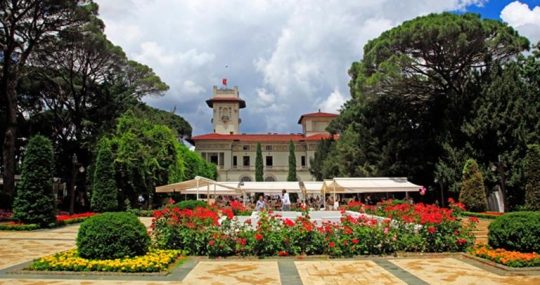
Palace Weddings on the Ottoman Dynasty
Shows and fireworks on the Golden Horn
That day the heart of Istanbul and of the empire was beating at this procession.
The participants wore their best outfits and carried their most valuable arms and pistols. Ahmet III was trying to show his power and wealth to his people with, this street parade instead of revealing his supremacy to the entire world in the battlefields. With the feasts and festivities he organized, with the mansions he had built during the Tulip Era and with all the luxury, he had changed the outlook of the capital city and ushered a new epoch in the Empire. The wedding day was a historic day for Istanbul. Everybody on the streets was happy. Joy was in the air. The streets were overcrowded. The windows were wide open. Faces beneath the veils were praying for the happiness of the bride and for the wealth, dashing look of the Sultan and his procession.
The procession was literally throwing money on the streets. People were stepping on each other to snap the coins. The procession arrived Eyiip, at the palace, prepared for Fatma Sultan. The procession participants disintegrated. Everyone had an entertainment to watch. Padishah and his wife went back to their palace. In the evening shows were staged on the Golden Horn, while fireworks were being lit on rafts.
Silahtar Ali Pasha dies in war
After this tiring and overwhelming wedding, which lasted for 25 days…
Silahtar Ali Pasha could not have Fatma Sultan. He had to send her back to the palace and wait for a while until she grows up and becomes a young lady. Silahtar Ali Pasha had to wait eight years for Fatma Sultan’s adolescence. He never had a chance to have a single private moment with her. Unfortunately, he died in Pclervaradin War before he could reunite with his fiancee, for whom he spent a fortune and organized feasts for weeks in order to gain supporters for his love. He became a martyr before he could realize his dreams.
Kosem Sultan marries her daughters
In the Ottoman Empire, the Sultans could marry before they were adolescents, but they could not share the same house with their spouses. This tradition was started by the well-known empress, Valide Kosem Sultan. For the sake of fortifying her position in the palace, Kosem Sultan married her minor daughters with the elite and reputable pashas of the time. Likewise, Ahmet 1 married her daughters Ayse Sultan and Fatma Sultan at the age of 13.
Sultan Ibrahim married Gevher Sultan at 3, Beyhan Sultan at 2. Emine, Ay§e and Safiye Sultans, the three daughters of Mustafa II, were married at 7. As mentioned above, Ahmet III had his daughters Fatma and Ummugulsum married at 5 and 2. Moreover, he married Atike Sultan at 12. Mustafa III married his son §ah Sultan at 3. This abnormality continued until the reign of MahmuL II, who pul an end to this situation and set the marriage time as the adolescence.
Multiple marriages
This weird tradition described above and the ongoing wars had a natural consequence. The sultans were widowed many times and were married more than once. The daughters of Ahmet I, Ayse, Fatma and Safiye, all married 6 times, which was a dynasty record. This record is followed by Safiye and Emine, daughters of Mustafa II, who married 4 times. So did Atike Sultan, daughter of Ahmet III.
Source: https://www.ensarislamoglu.com/palace-weddings-ottoman-dynasty/
0 notes
Photo

Palace Weddings on the Ottoman Dynasty
Shows and fireworks on the Golden Horn
That day the heart of Istanbul and of the empire was beating at this procession.
The participants wore their best outfits and carried their most valuable arms and pistols. Ahmet III was trying to show his power and wealth to his people with, this street parade instead of revealing his supremacy to the entire world in the battlefields. With the feasts and festivities he organized, with the mansions he had built during the Tulip Era and with all the luxury, he had changed the outlook of the capital city and ushered a new epoch in the Empire. The wedding day was a historic day for Istanbul. Everybody on the streets was happy. Joy was in the air. The streets were overcrowded. The windows were wide open. Faces beneath the veils were praying for the happiness of the bride and for the wealth, dashing look of the Sultan and his procession.
The procession was literally throwing money on the streets. People were stepping on each other to snap the coins. The procession arrived Eyiip, at the palace, prepared for Fatma Sultan. The procession participants disintegrated. Everyone had an entertainment to watch. Padishah and his wife went back to their palace. In the evening shows were staged on the Golden Horn, while fireworks were being lit on rafts.
Silahtar Ali Pasha dies in war
After this tiring and overwhelming wedding, which lasted for 25 days…
Silahtar Ali Pasha could not have Fatma Sultan. He had to send her back to the palace and wait for a while until she grows up and becomes a young lady. Silahtar Ali Pasha had to wait eight years for Fatma Sultan’s adolescence. He never had a chance to have a single private moment with her. Unfortunately, he died in Pclervaradin War before he could reunite with his fiancee, for whom he spent a fortune and organized feasts for weeks in order to gain supporters for his love. He became a martyr before he could realize his dreams.
Kosem Sultan marries her daughters
In the Ottoman Empire, the Sultans could marry before they were adolescents, but they could not share the same house with their spouses. This tradition was started by the well-known empress, Valide Kosem Sultan. For the sake of fortifying her position in the palace, Kosem Sultan married her minor daughters with the elite and reputable pashas of the time. Likewise, Ahmet 1 married her daughters Ayse Sultan and Fatma Sultan at the age of 13.
Sultan Ibrahim married Gevher Sultan at 3, Beyhan Sultan at 2. Emine, Ay§e and Safiye Sultans, the three daughters of Mustafa II, were married at 7. As mentioned above, Ahmet III had his daughters Fatma and Ummugulsum married at 5 and 2. Moreover, he married Atike Sultan at 12. Mustafa III married his son §ah Sultan at 3. This abnormality continued until the reign of MahmuL II, who pul an end to this situation and set the marriage time as the adolescence.
Multiple marriages
This weird tradition described above and the ongoing wars had a natural consequence. The sultans were widowed many times and were married more than once. The daughters of Ahmet I, Ayse, Fatma and Safiye, all married 6 times, which was a dynasty record. This record is followed by Safiye and Emine, daughters of Mustafa II, who married 4 times. So did Atike Sultan, daughter of Ahmet III.
Source: https://www.ensarislamoglu.com/palace-weddings-ottoman-dynasty/
0 notes
Text
Yes to all of this! I thought this exact thing about Mahidevran only enabling Hatice's toxic attitude towards Hürrem. And oh God I haven't thought of it that much, but sending Hatice to Beyhan would be a great idea for the exact reasons you mentioned!
And yeah, I didn't even realize it, but it is striking how much better Süleyman is as a brother than a father. Chalk it up to traumabonding in childhood and his messed up relationship with his own father.
Another interesting aspect of his character is his firm refusal to ever, ever explain himself. Even if Ibrahim's crimes weren't made public exactly, but at least Hatice should know. Similarly when Mihrimah asked about the reasons for her mother's banishment. Is it some strange attempt to preserve the honor of the people he punished? Does he just compulsively perceive even the most polite request for an explanation as an insult? And yeah, part of it is probably just because if Süleyman's sisters ever understood that he had his reasons completely unrelated to Hürrem, there would be no "avenging Ibrahim" plot, but still. It's a remarkably consistent behavior.
YES Gülfem was wasted as hell! Like, we could have some interesting stuff with her and Hatice, even if we don't interpret her as in love with Hatice, which we should. We should also consider the possibility of her projecting her hopeless feelings on Ibrahim, which is why she ships him and Hatice to such an extent... But other than that, exploring Gülfem's interiority would be a fascinating ordeal. With her son, she seemingly lost her purpose in the eyes of the royal family, and so she basically became Hatice's handmaiden. Except not really, because Süleyman still likes her and wants her around so much she's not expected to follow Hatice into her new home. What is she now, then? Other character are clearly servants, favourites, sultanas, even noble ladies, but Gülfem seemingly doesn't belong to any of these categories. Noone orders her around, nor does she order anyone around either (at least noone important with actual lines). She's just... There. You'd think they would, like, marry her off or sent to the Old Palace or something. Is it really just that the royal family likes her and doesn't want to get rid of her? Because that could be a fascinating position to explore.
And honestly, if this show was historically accurate, Gülfem absolutely wouldn't be alone. Not just because there would be other mothers of Süleyman's dead kids, but because the princes would have children who died very young as well (even in the show, imagine if Fatma didn't lose her mind immediately!). Especially during Kösem, mothers of dead children would outnumber the ones whose kids are still alive. I've heard that even for that era, child mortality rate in Topkapi was pretty fucking bad. More than half of the children Murat IV. had died prematurely, including all of his sons. I so wish the show would have the balls to reflect that reality, especially since it adapted other darker aspects of the era (i.e. executions of the little princes) anyway.








This conversation should have been the end for Hatice. Suleyman shouldn't have told her go or I'm taking your children, he should have left her palace with strict order to the guards and other servants that she wasn't allowed to leave or have visitors. Then made arrangements for her children to be raised by one of his other sisters, most likely Beyhan. Followed by arrangements for Hatice to be sent to a hospital or secluded palace indefinitely with strict rules and control on any contact she has with people outside of the people cearing for her.
The writers dropped the ball on Suleyman post Ibrahim's execution, he should have been less willing to put up with people's bullshit and self motivated decisions. He should have been written so that the audience questions whether he's being needlessly cruel or if the decisions and actions of those closest to him have forced him to be more decisive and heavy handed.
29 notes
·
View notes
Photo
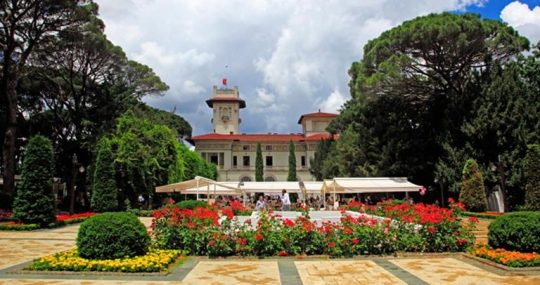
Palace Weddings on the Ottoman Dynasty
Shows and fireworks on the Golden Horn
That day the heart of Istanbul and of the empire was beating at this procession.
The participants wore their best outfits and carried their most valuable arms and pistols. Ahmet III was trying to show his power and wealth to his people with, this street parade instead of revealing his supremacy to the entire world in the battlefields. With the feasts and festivities he organized, with the mansions he had built during the Tulip Era and with all the luxury, he had changed the outlook of the capital city and ushered a new epoch in the Empire. The wedding day was a historic day for Istanbul. Everybody on the streets was happy. Joy was in the air. The streets were overcrowded. The windows were wide open. Faces beneath the veils were praying for the happiness of the bride and for the wealth, dashing look of the Sultan and his procession.
The procession was literally throwing money on the streets. People were stepping on each other to snap the coins. The procession arrived Eyiip, at the palace, prepared for Fatma Sultan. The procession participants disintegrated. Everyone had an entertainment to watch. Padishah and his wife went back to their palace. In the evening shows were staged on the Golden Horn, while fireworks were being lit on rafts.
Silahtar Ali Pasha dies in war
After this tiring and overwhelming wedding, which lasted for 25 days…
Silahtar Ali Pasha could not have Fatma Sultan. He had to send her back to the palace and wait for a while until she grows up and becomes a young lady. Silahtar Ali Pasha had to wait eight years for Fatma Sultan’s adolescence. He never had a chance to have a single private moment with her. Unfortunately, he died in Pclervaradin War before he could reunite with his fiancee, for whom he spent a fortune and organized feasts for weeks in order to gain supporters for his love. He became a martyr before he could realize his dreams.
Kosem Sultan marries her daughters
In the Ottoman Empire, the Sultans could marry before they were adolescents, but they could not share the same house with their spouses. This tradition was started by the well-known empress, Valide Kosem Sultan. For the sake of fortifying her position in the palace, Kosem Sultan married her minor daughters with the elite and reputable pashas of the time. Likewise, Ahmet 1 married her daughters Ayse Sultan and Fatma Sultan at the age of 13.
Sultan Ibrahim married Gevher Sultan at 3, Beyhan Sultan at 2. Emine, Ay§e and Safiye Sultans, the three daughters of Mustafa II, were married at 7. As mentioned above, Ahmet III had his daughters Fatma and Ummugulsum married at 5 and 2. Moreover, he married Atike Sultan at 12. Mustafa III married his son §ah Sultan at 3. This abnormality continued until the reign of MahmuL II, who pul an end to this situation and set the marriage time as the adolescence.
Multiple marriages
This weird tradition described above and the ongoing wars had a natural consequence. The sultans were widowed many times and were married more than once. The daughters of Ahmet I, Ayse, Fatma and Safiye, all married 6 times, which was a dynasty record. This record is followed by Safiye and Emine, daughters of Mustafa II, who married 4 times. So did Atike Sultan, daughter of Ahmet III.
Source: https://www.ensarislamoglu.com/palace-weddings-ottoman-dynasty/
0 notes
Photo
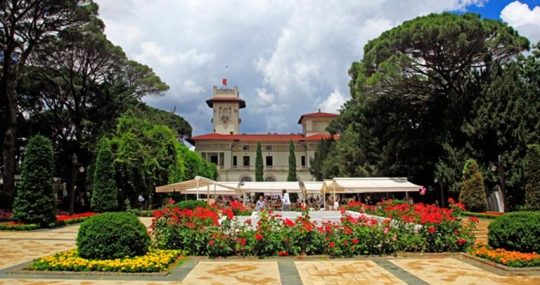
Palace Weddings on the Ottoman Dynasty
Shows and fireworks on the Golden Horn
That day the heart of Istanbul and of the empire was beating at this procession.
The participants wore their best outfits and carried their most valuable arms and pistols. Ahmet III was trying to show his power and wealth to his people with, this street parade instead of revealing his supremacy to the entire world in the battlefields. With the feasts and festivities he organized, with the mansions he had built during the Tulip Era and with all the luxury, he had changed the outlook of the capital city and ushered a new epoch in the Empire. The wedding day was a historic day for Istanbul. Everybody on the streets was happy. Joy was in the air. The streets were overcrowded. The windows were wide open. Faces beneath the veils were praying for the happiness of the bride and for the wealth, dashing look of the Sultan and his procession.
The procession was literally throwing money on the streets. People were stepping on each other to snap the coins. The procession arrived Eyiip, at the palace, prepared for Fatma Sultan. The procession participants disintegrated. Everyone had an entertainment to watch. Padishah and his wife went back to their palace. In the evening shows were staged on the Golden Horn, while fireworks were being lit on rafts.
Silahtar Ali Pasha dies in war
After this tiring and overwhelming wedding, which lasted for 25 days…
Silahtar Ali Pasha could not have Fatma Sultan. He had to send her back to the palace and wait for a while until she grows up and becomes a young lady. Silahtar Ali Pasha had to wait eight years for Fatma Sultan’s adolescence. He never had a chance to have a single private moment with her. Unfortunately, he died in Pclervaradin War before he could reunite with his fiancee, for whom he spent a fortune and organized feasts for weeks in order to gain supporters for his love. He became a martyr before he could realize his dreams.
Kosem Sultan marries her daughters
In the Ottoman Empire, the Sultans could marry before they were adolescents, but they could not share the same house with their spouses. This tradition was started by the well-known empress, Valide Kosem Sultan. For the sake of fortifying her position in the palace, Kosem Sultan married her minor daughters with the elite and reputable pashas of the time. Likewise, Ahmet 1 married her daughters Ayse Sultan and Fatma Sultan at the age of 13.
Sultan Ibrahim married Gevher Sultan at 3, Beyhan Sultan at 2. Emine, Ay§e and Safiye Sultans, the three daughters of Mustafa II, were married at 7. As mentioned above, Ahmet III had his daughters Fatma and Ummugulsum married at 5 and 2. Moreover, he married Atike Sultan at 12. Mustafa III married his son §ah Sultan at 3. This abnormality continued until the reign of MahmuL II, who pul an end to this situation and set the marriage time as the adolescence.
Multiple marriages
This weird tradition described above and the ongoing wars had a natural consequence. The sultans were widowed many times and were married more than once. The daughters of Ahmet I, Ayse, Fatma and Safiye, all married 6 times, which was a dynasty record. This record is followed by Safiye and Emine, daughters of Mustafa II, who married 4 times. So did Atike Sultan, daughter of Ahmet III.
Source: https://www.ensarislamoglu.com/palace-weddings-ottoman-dynasty/
0 notes